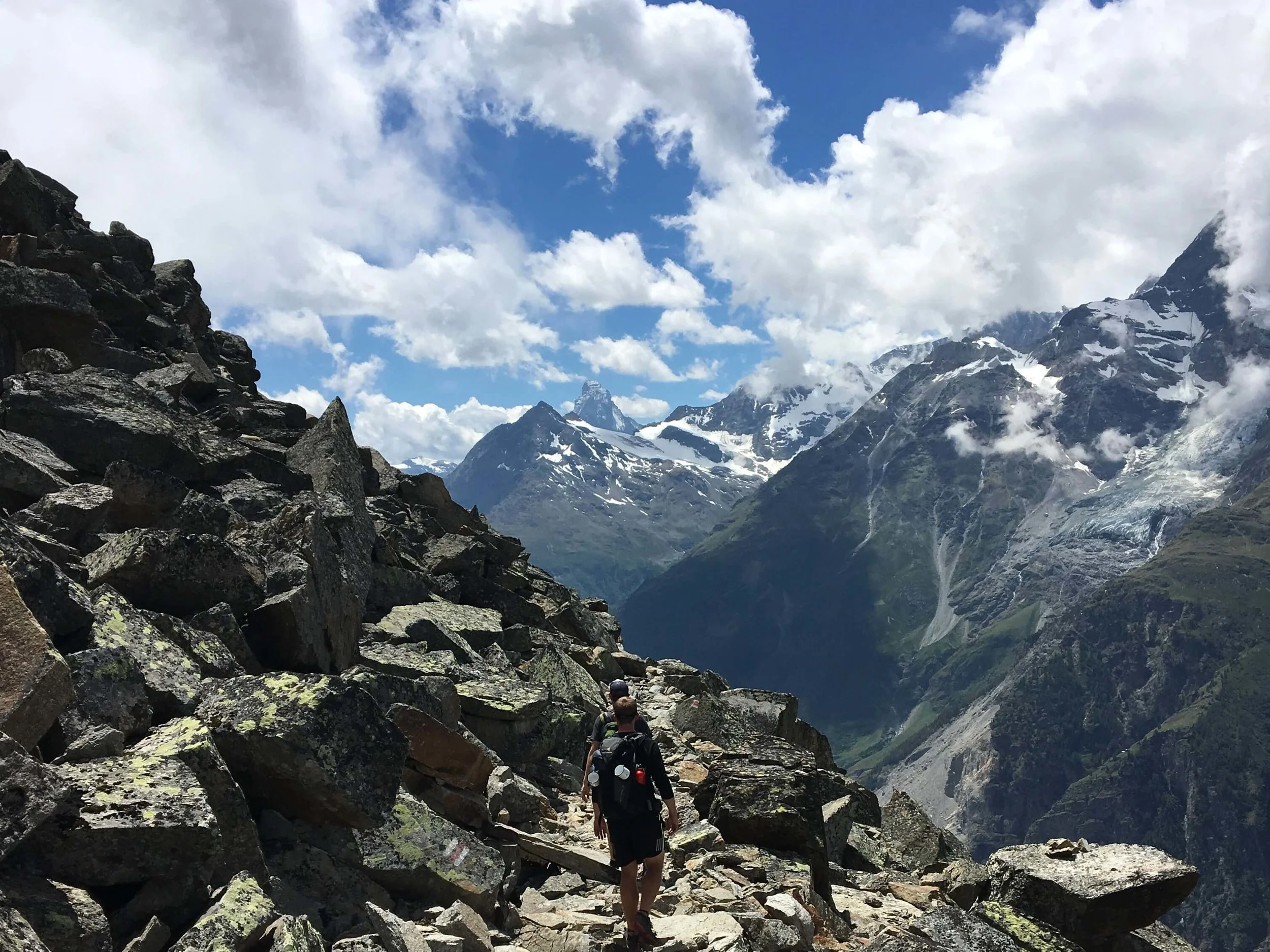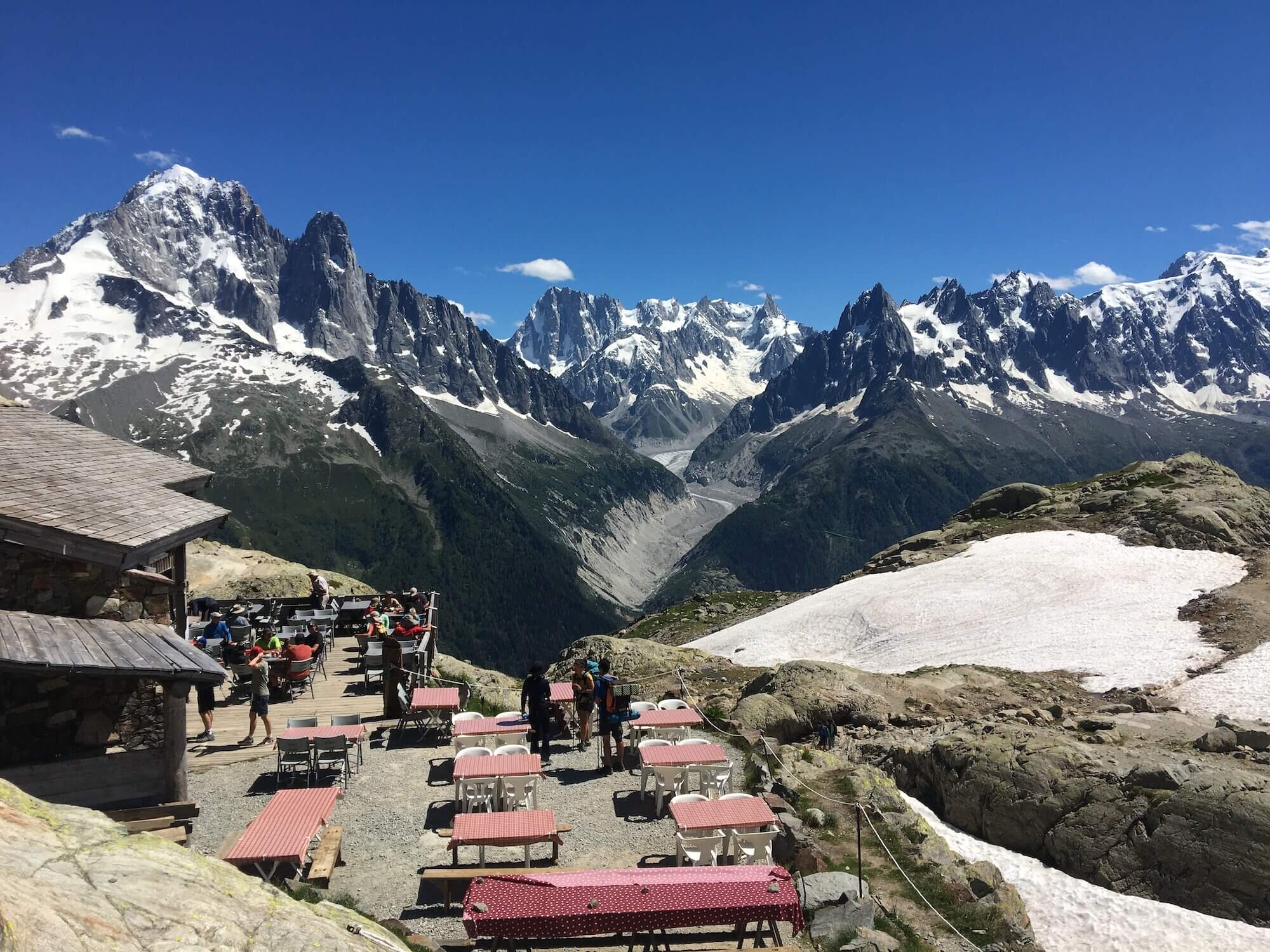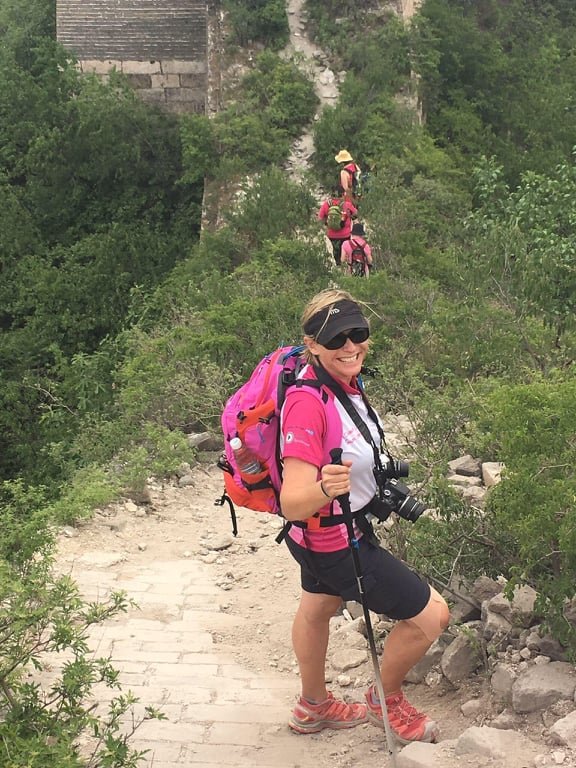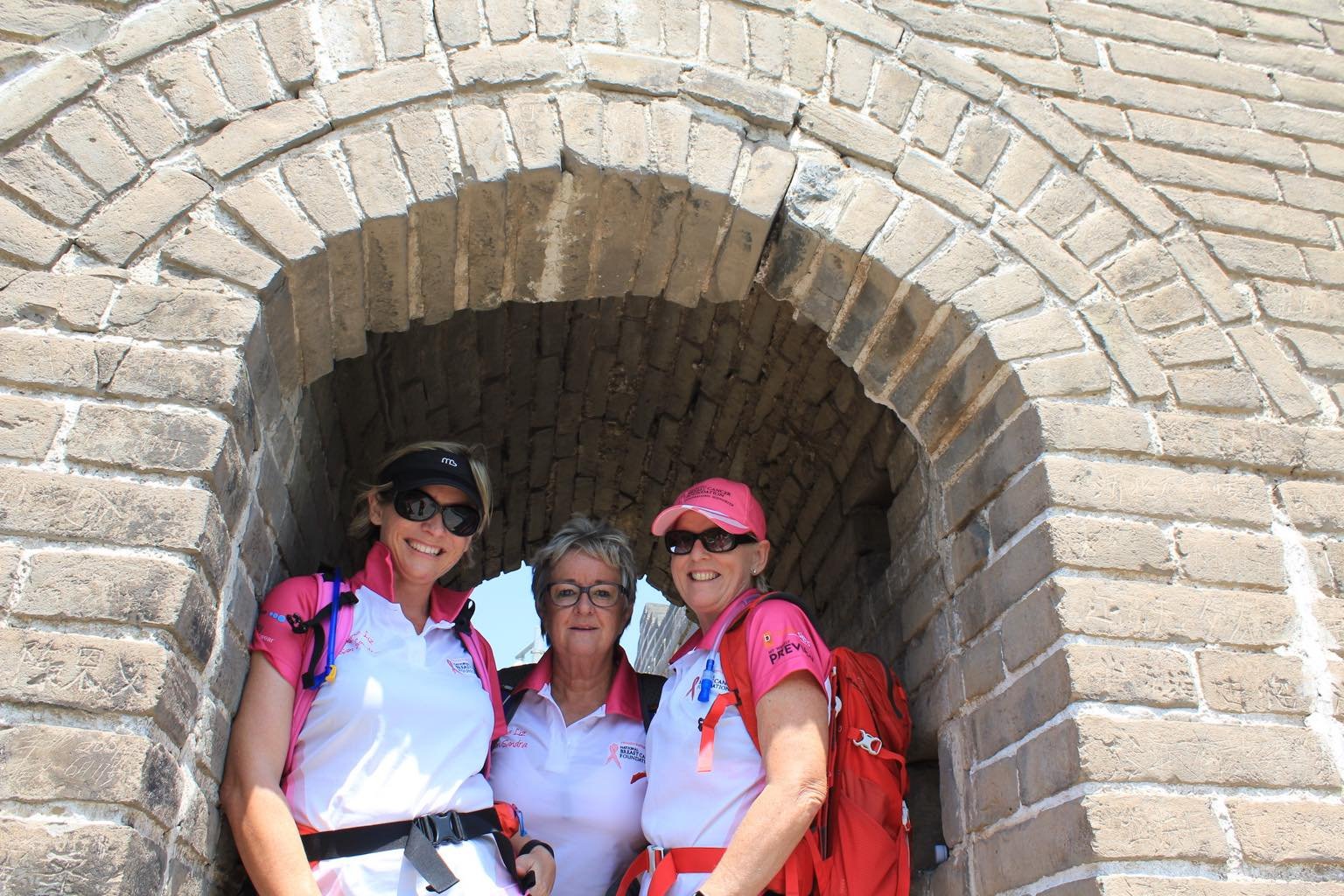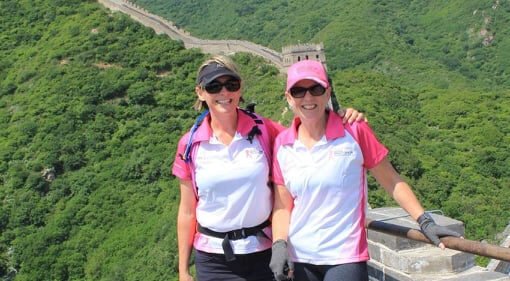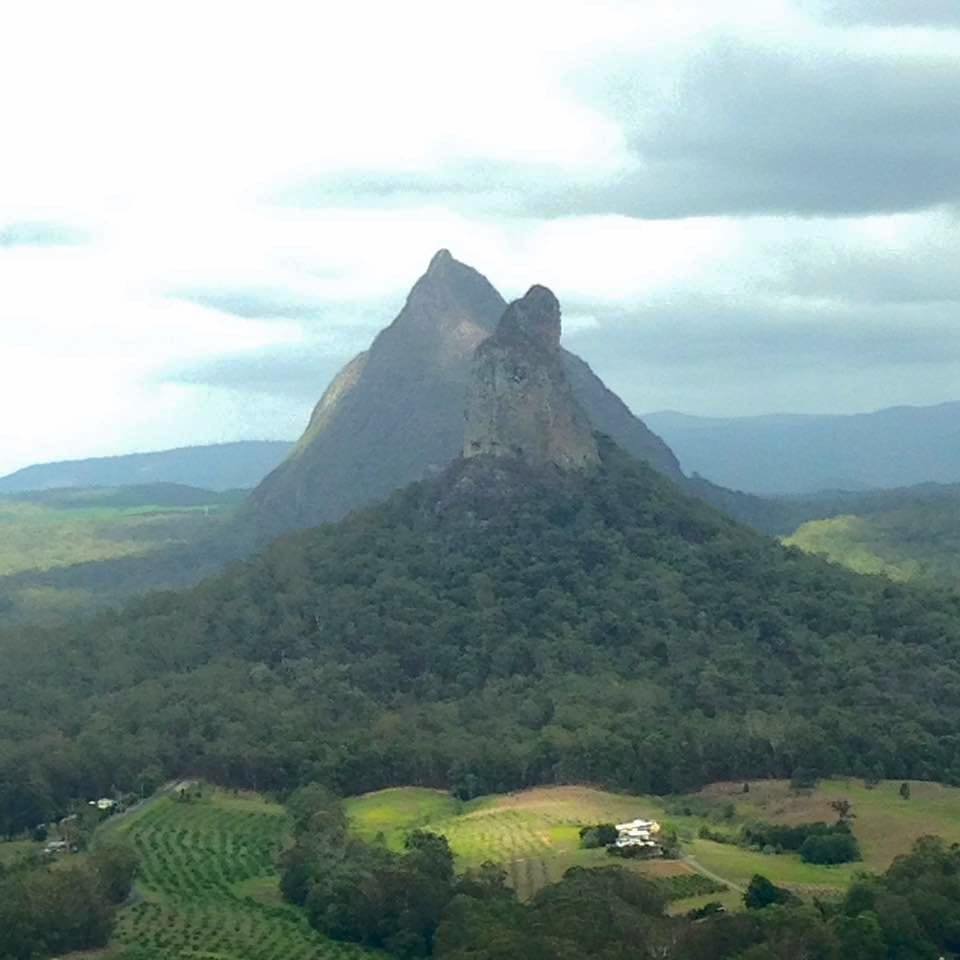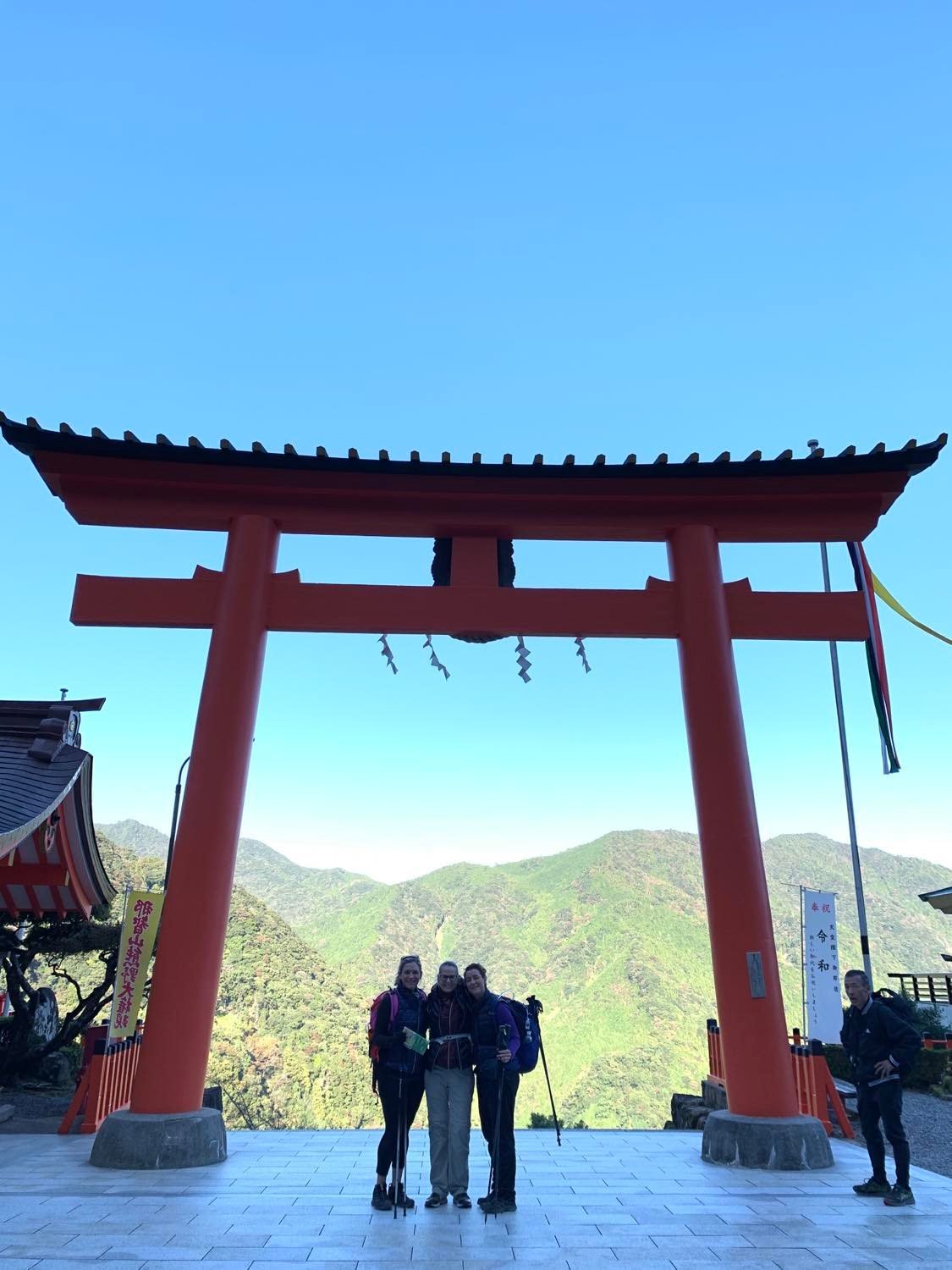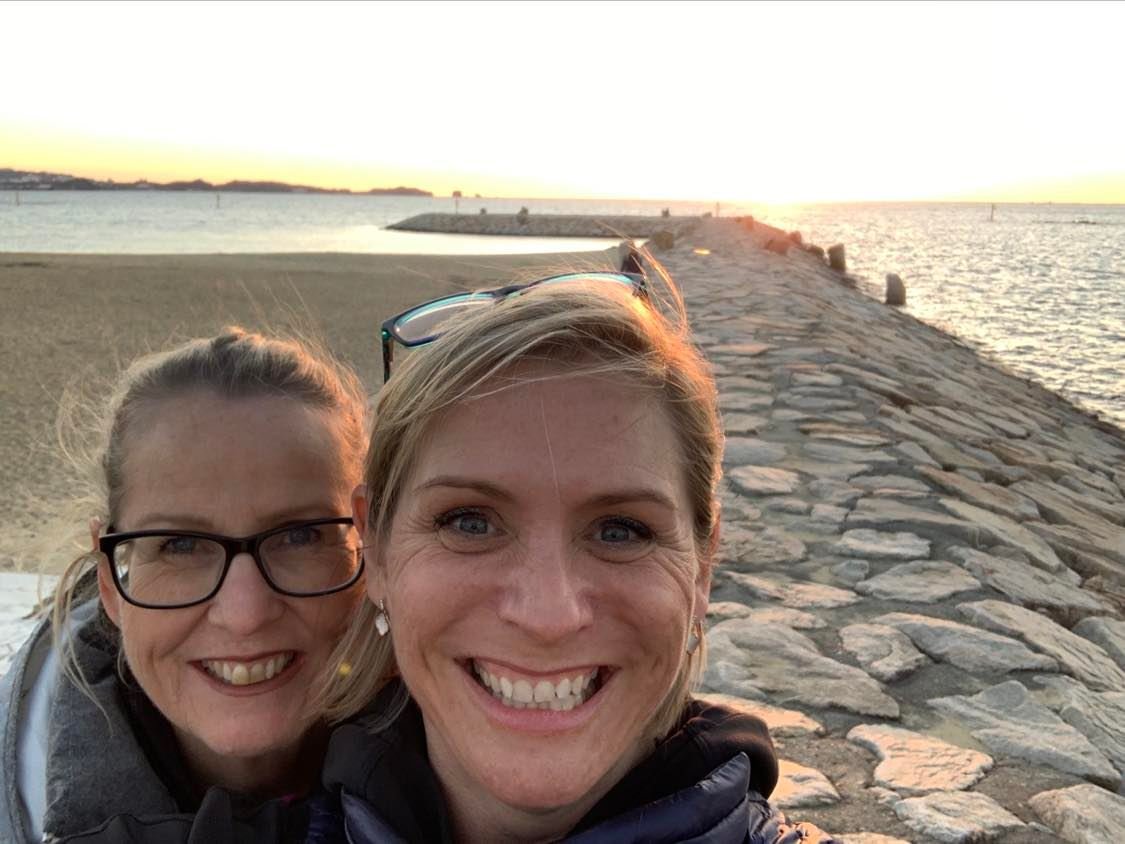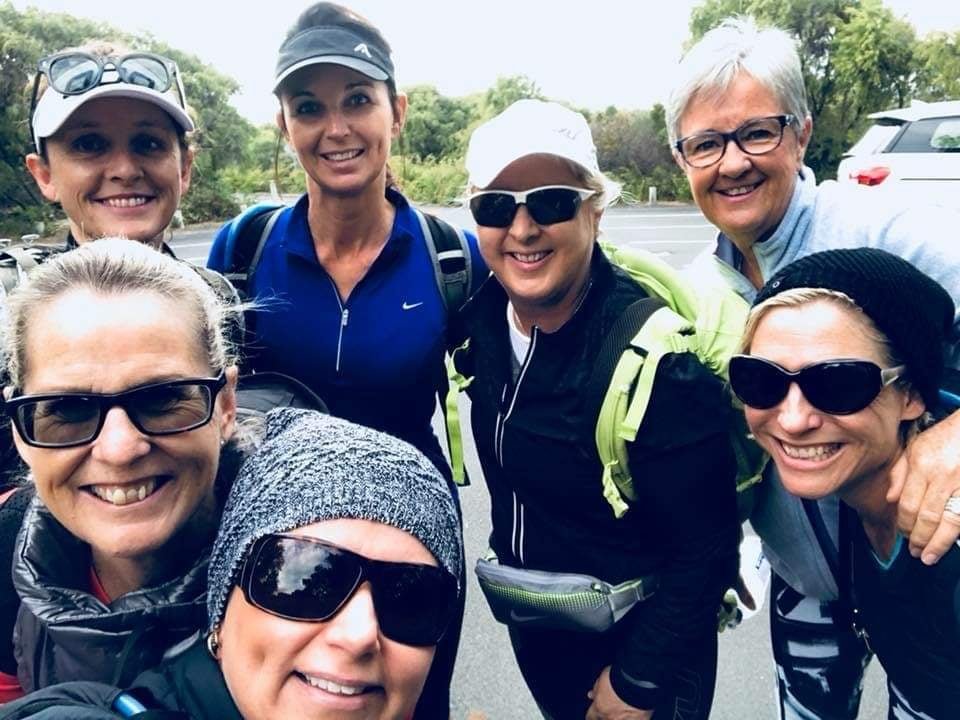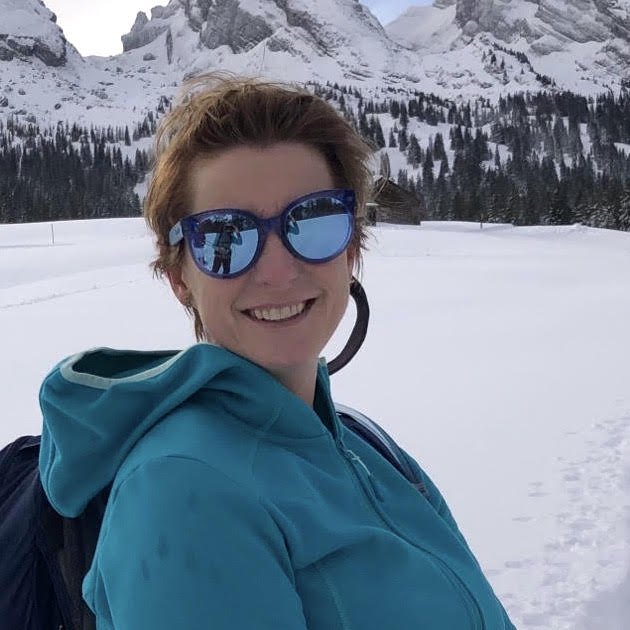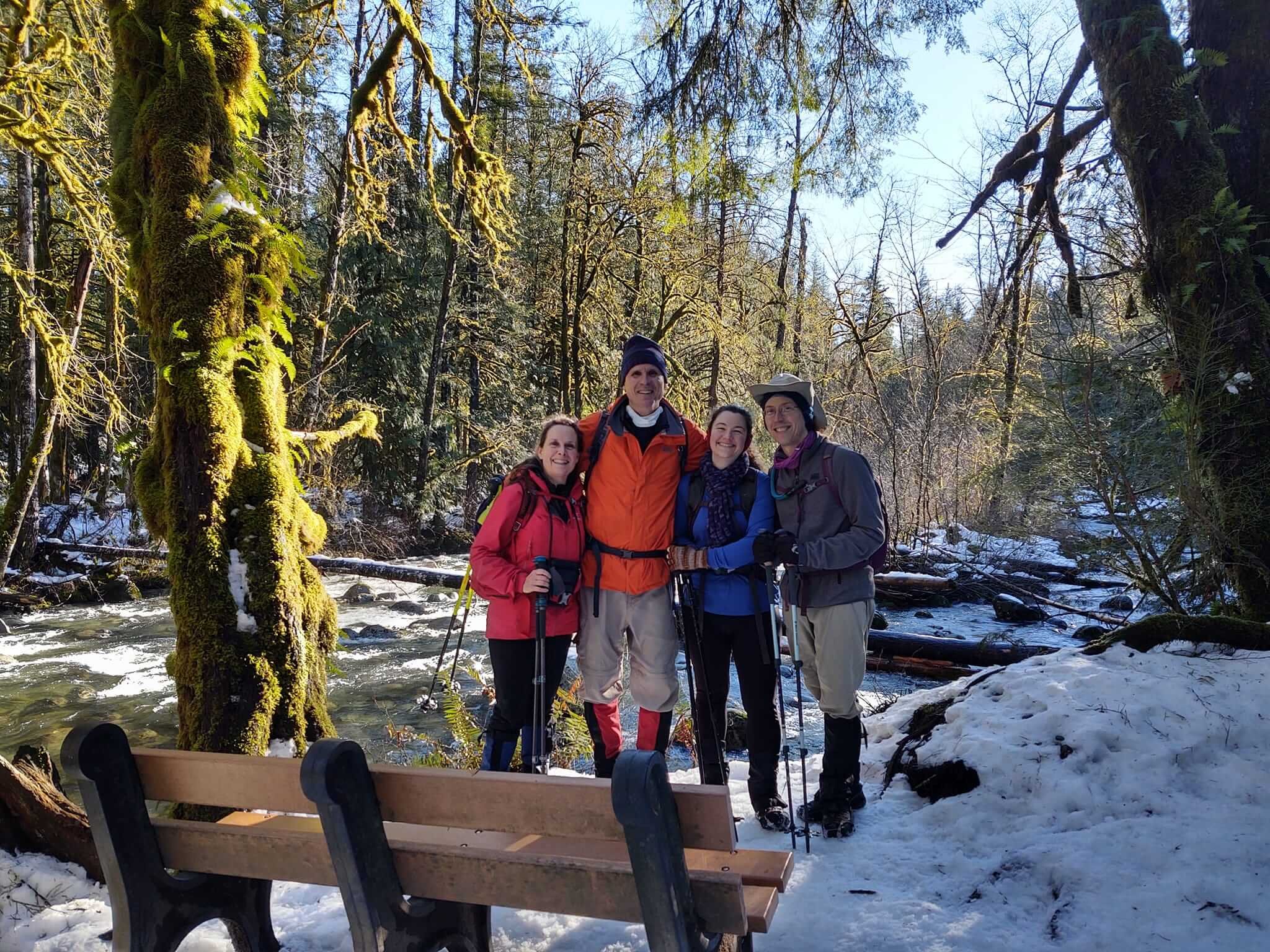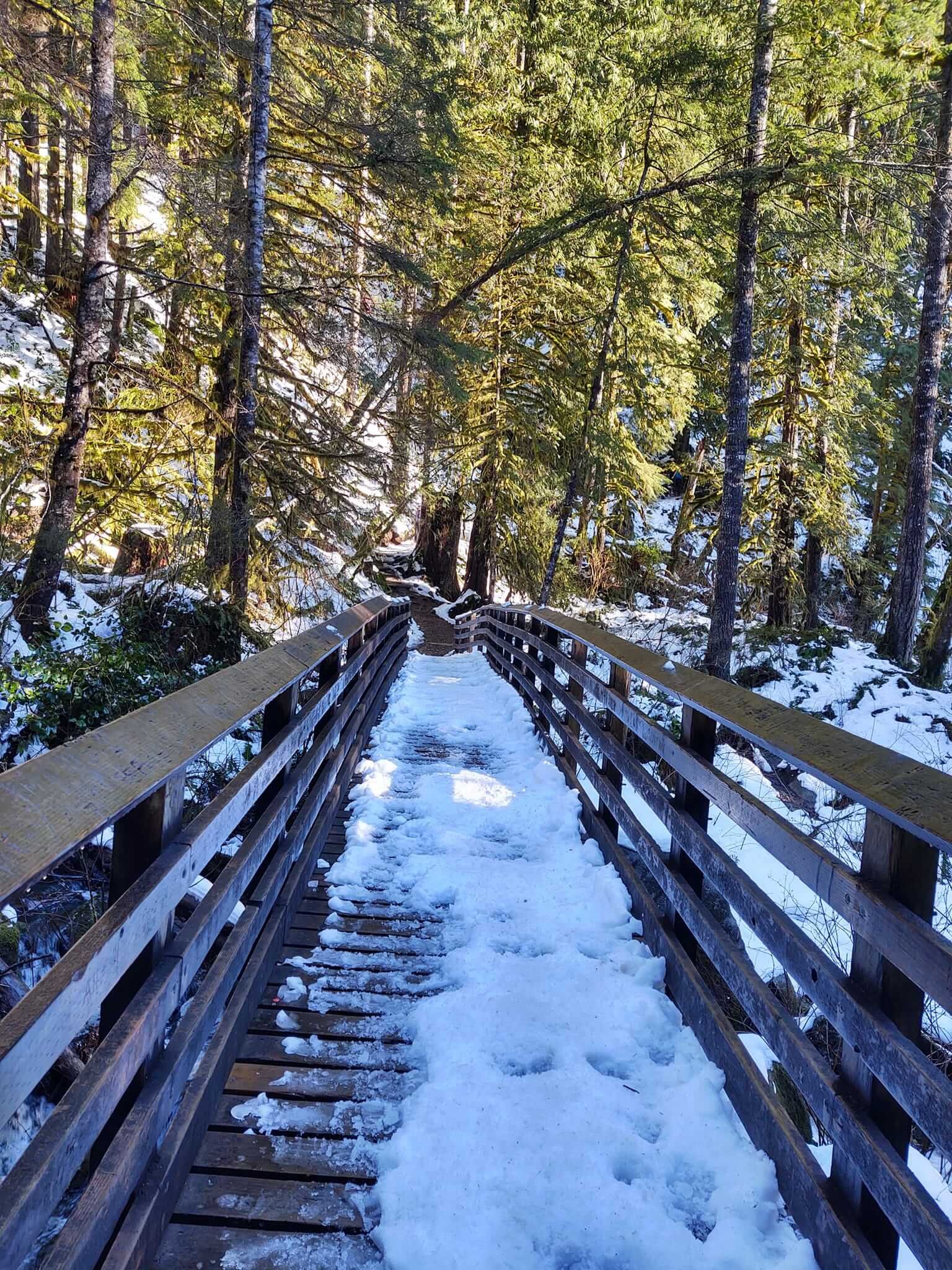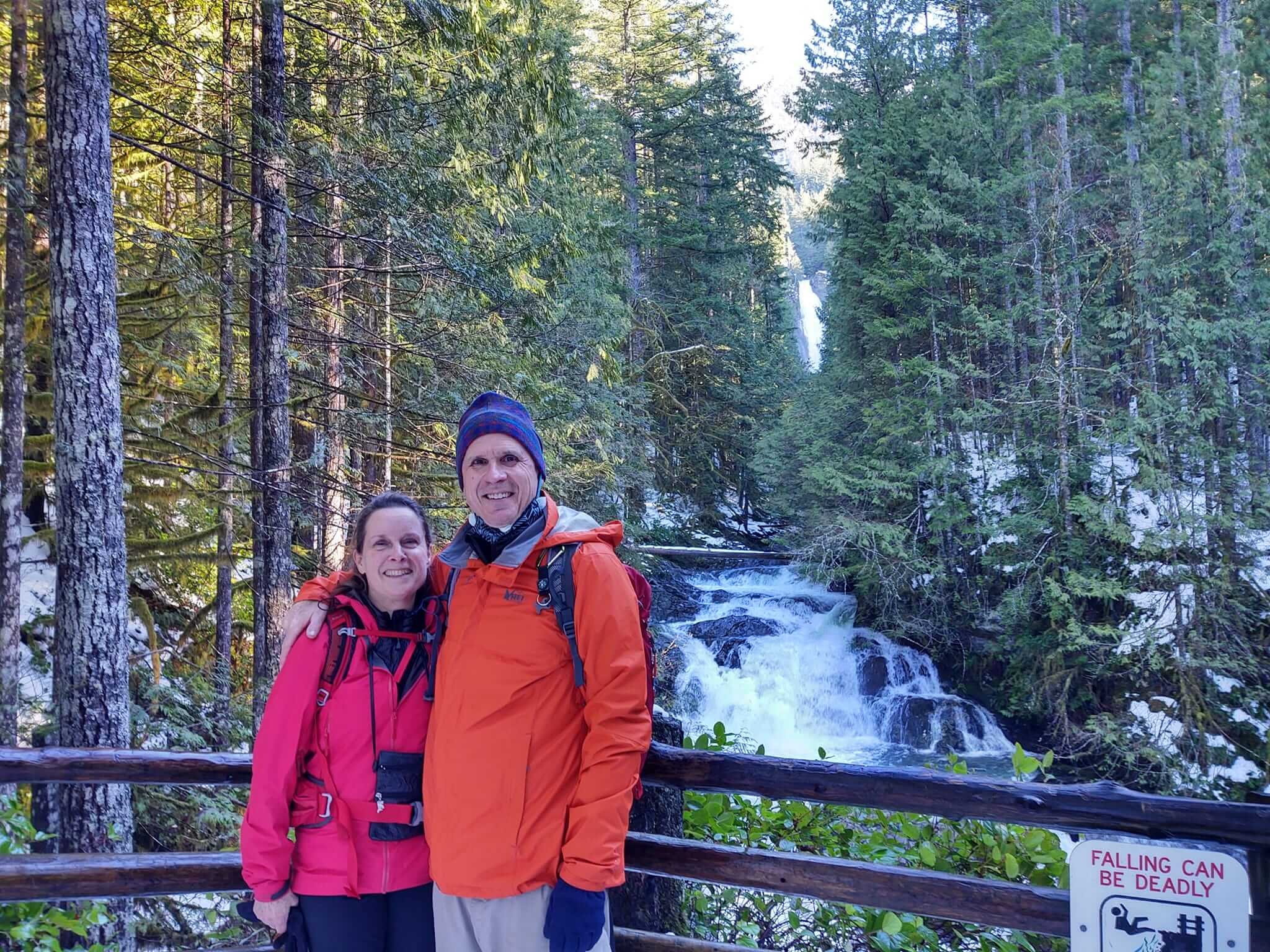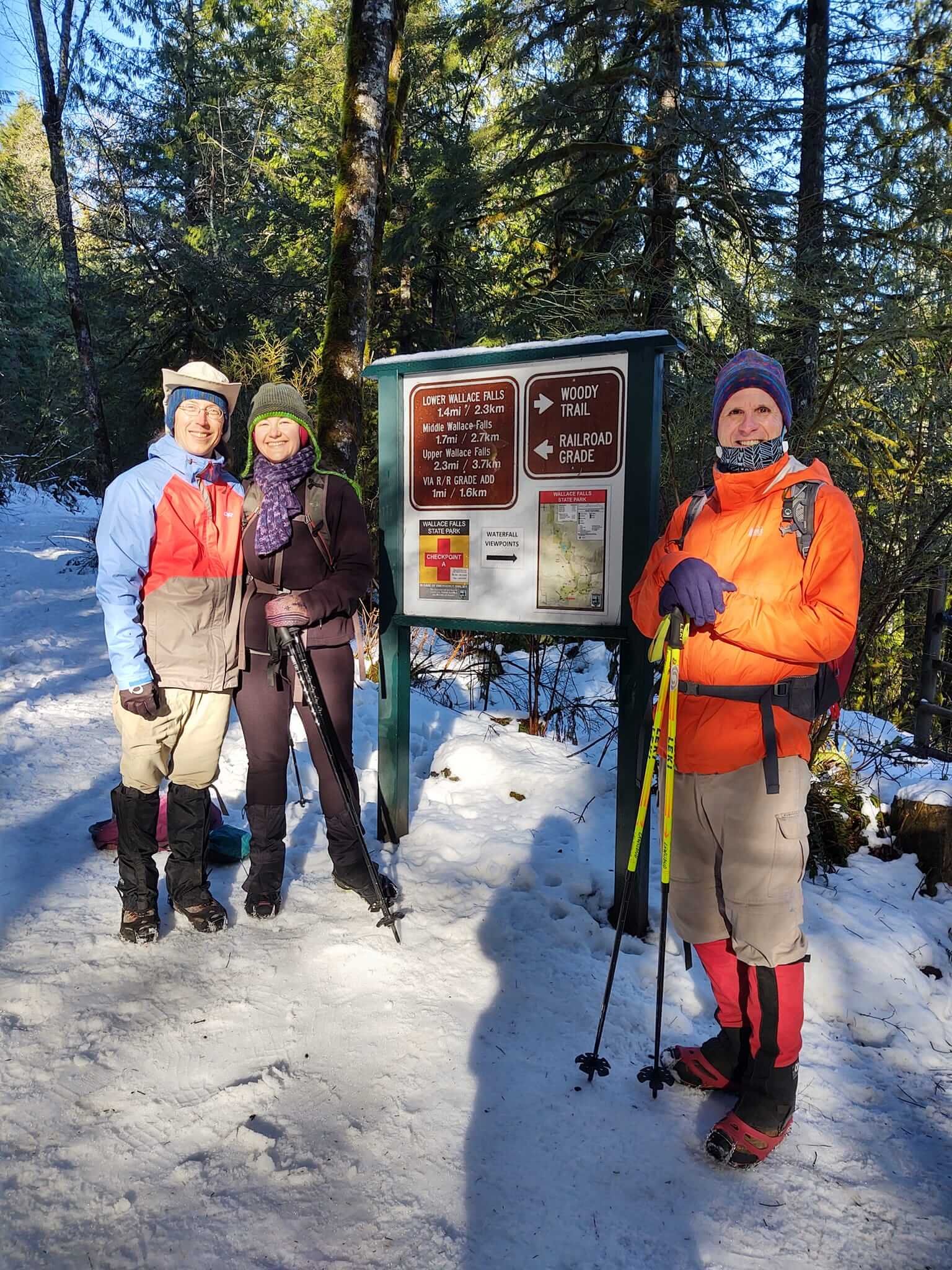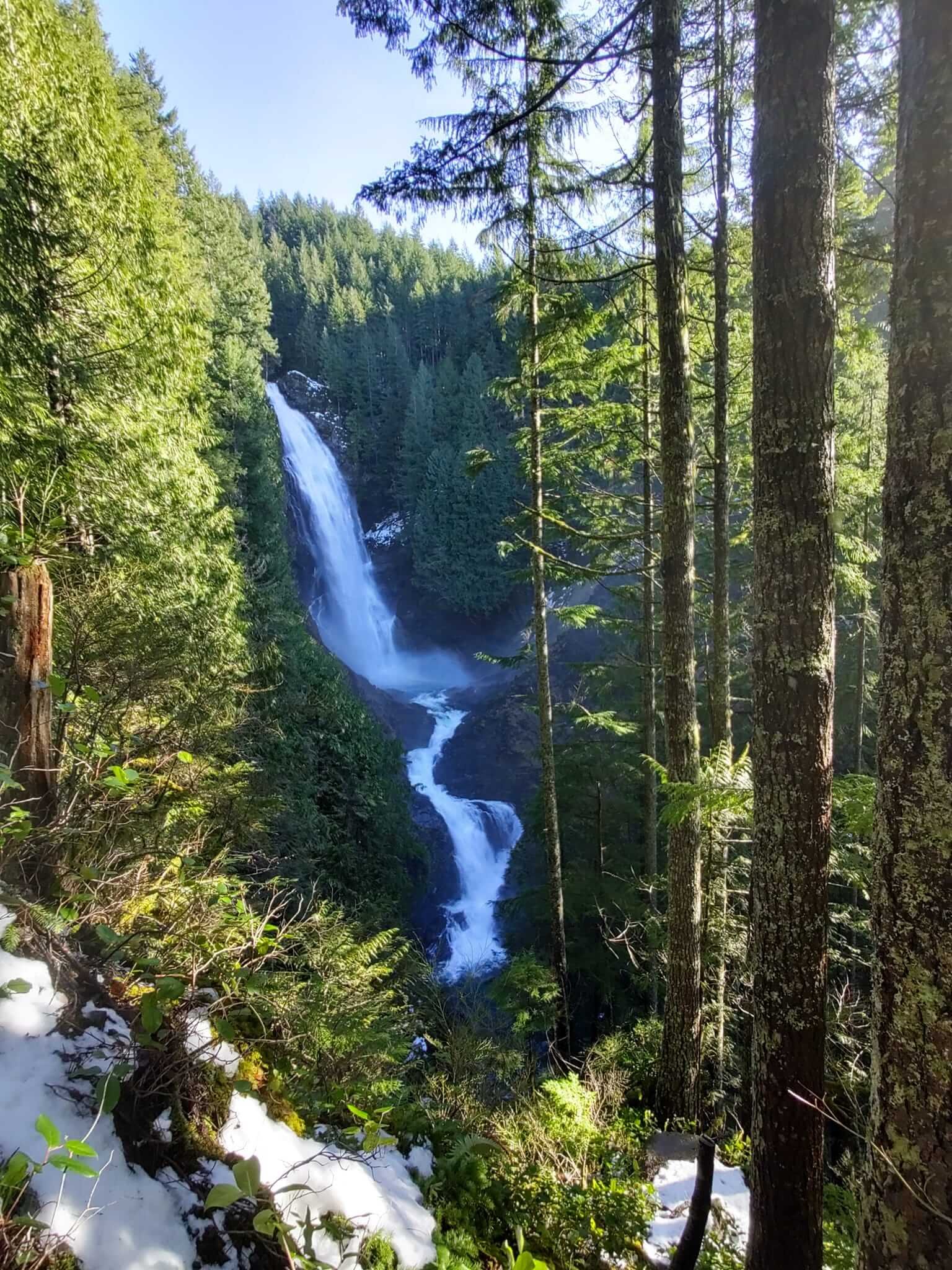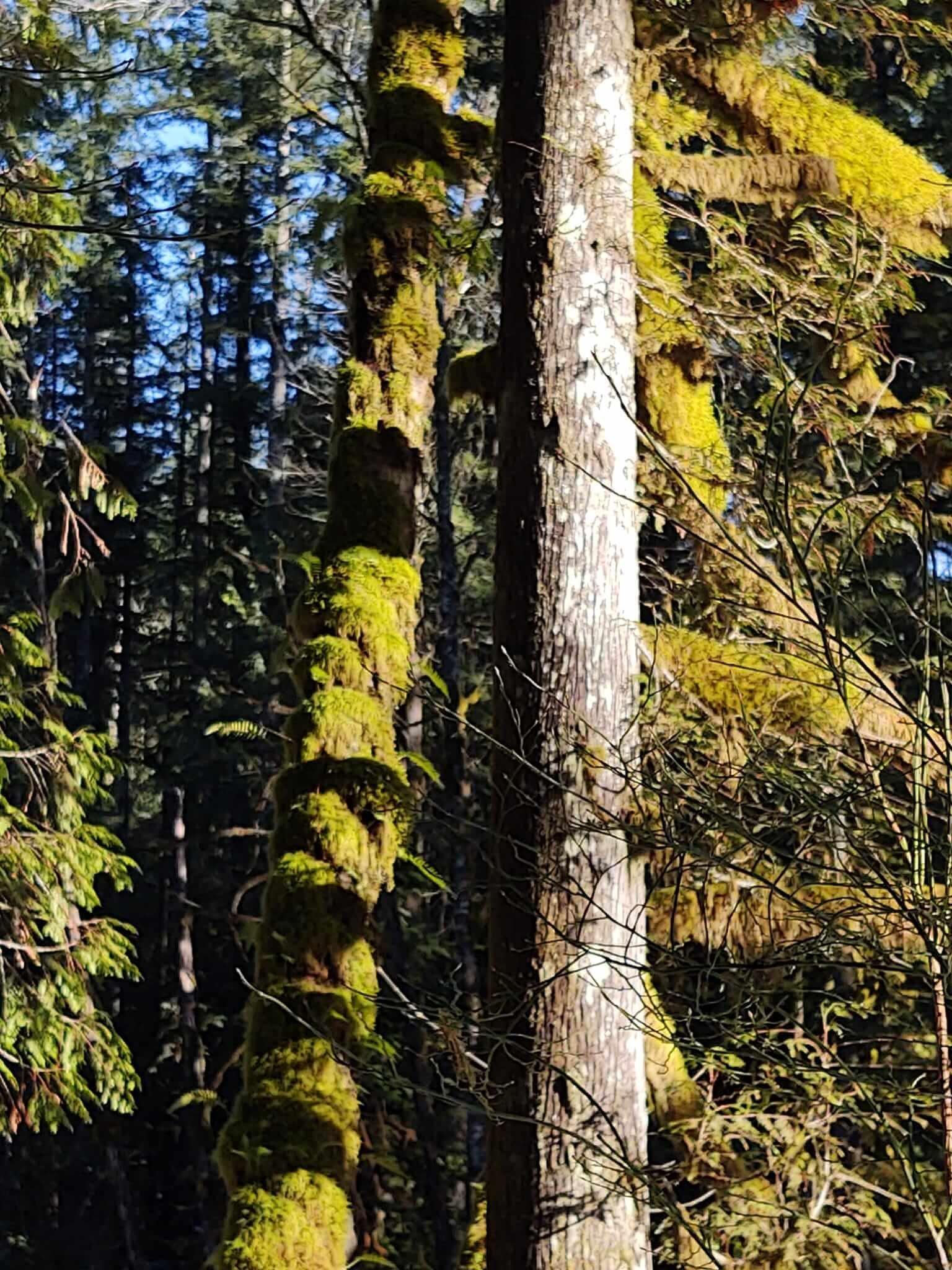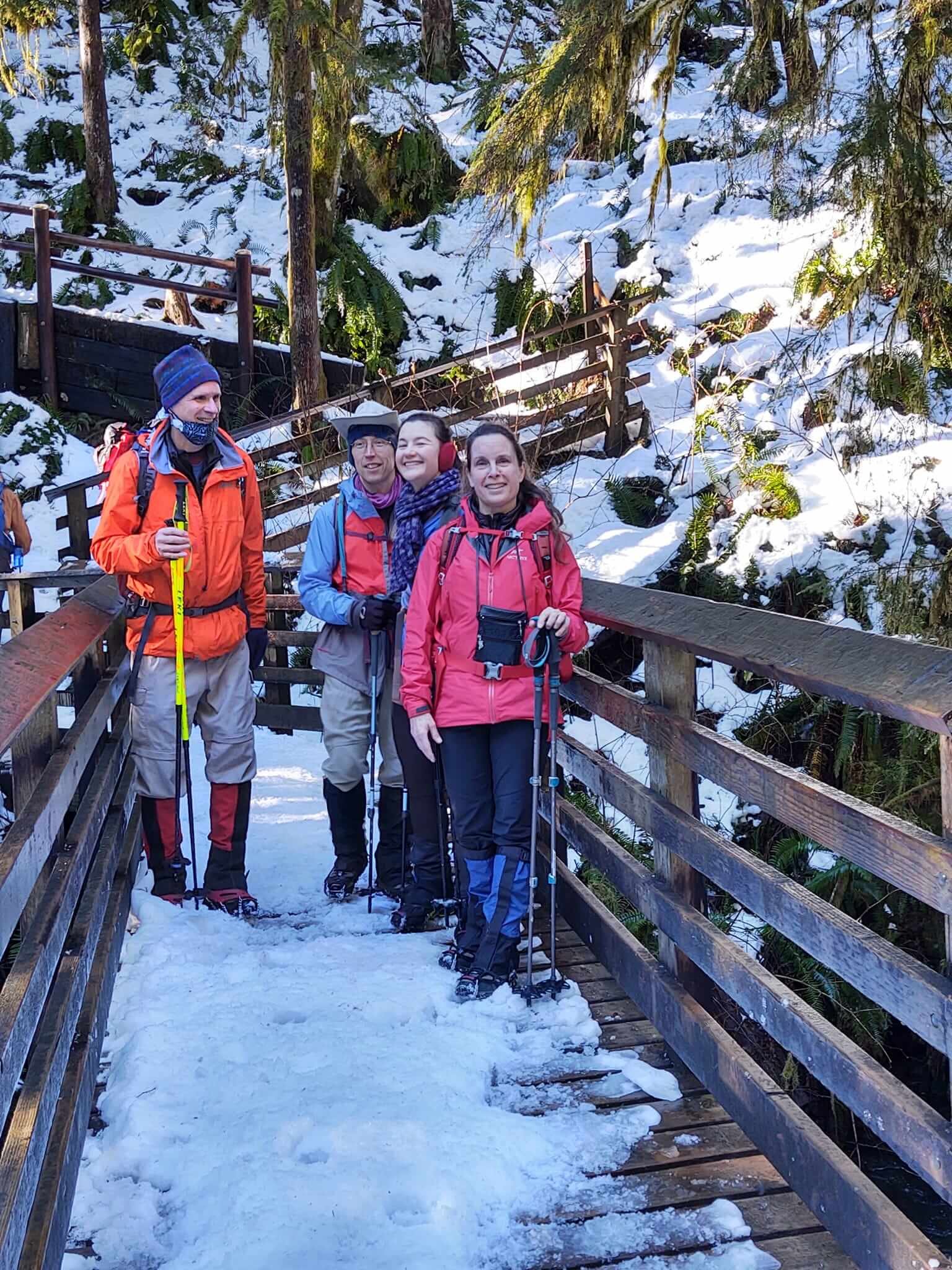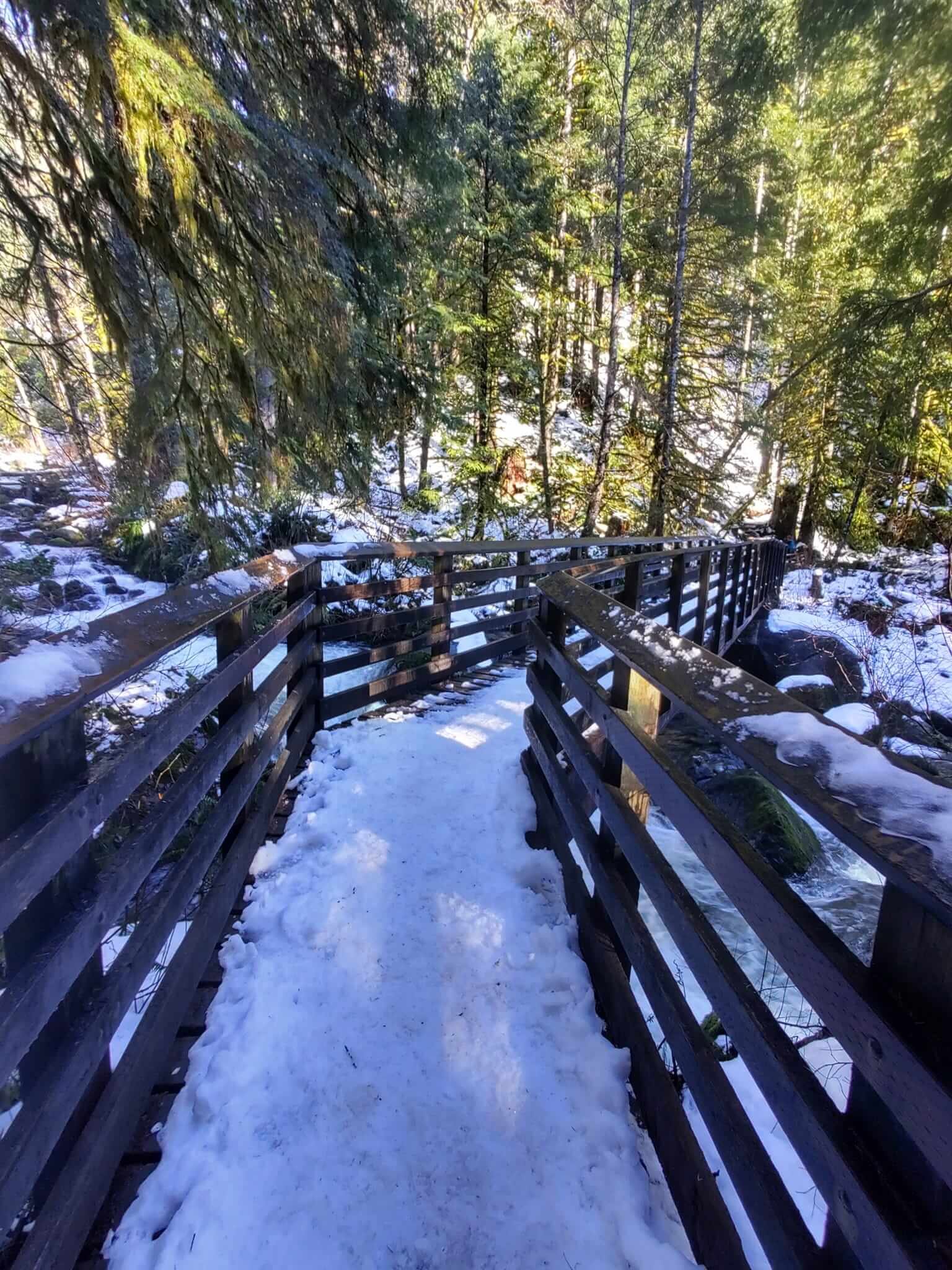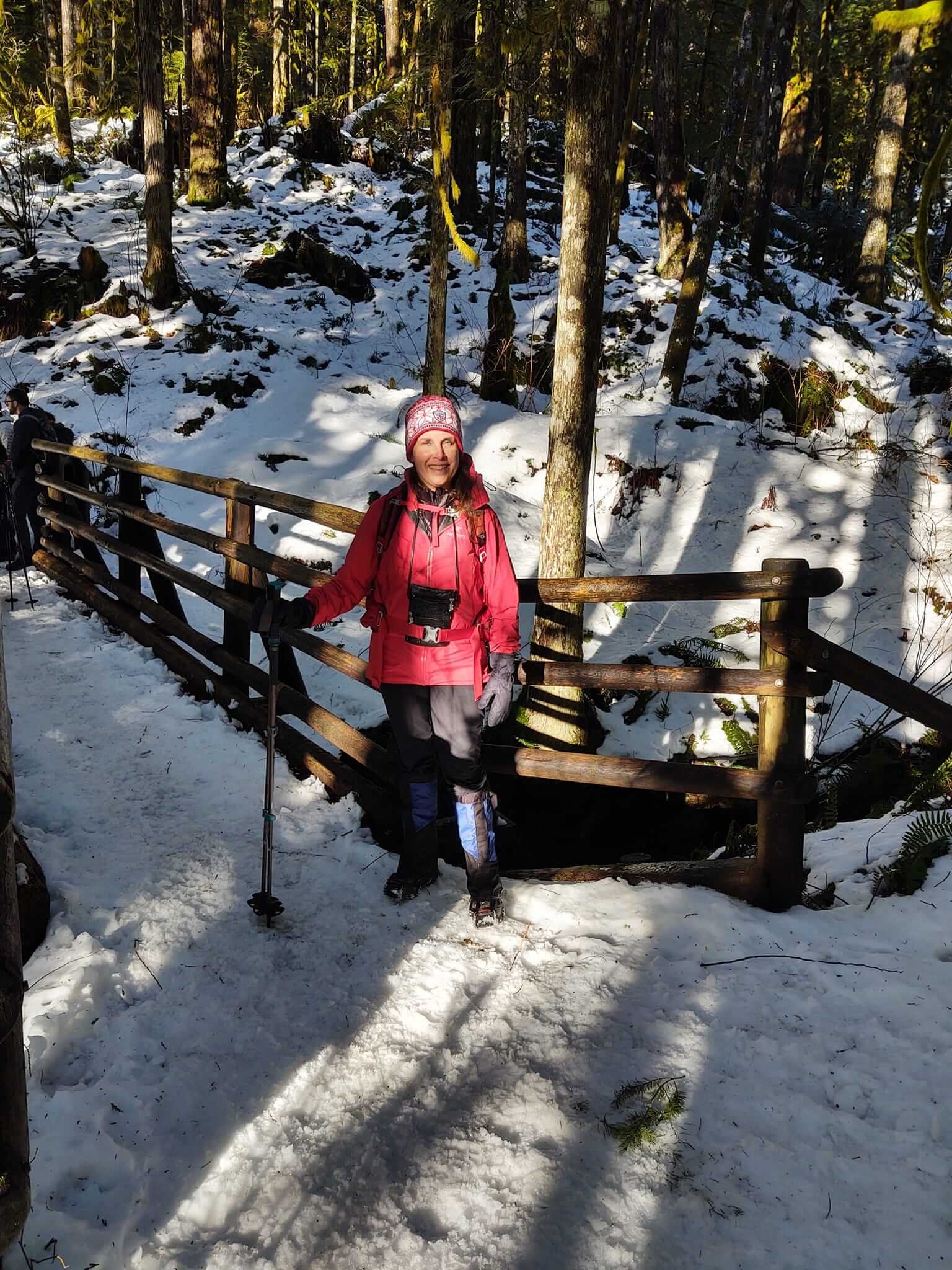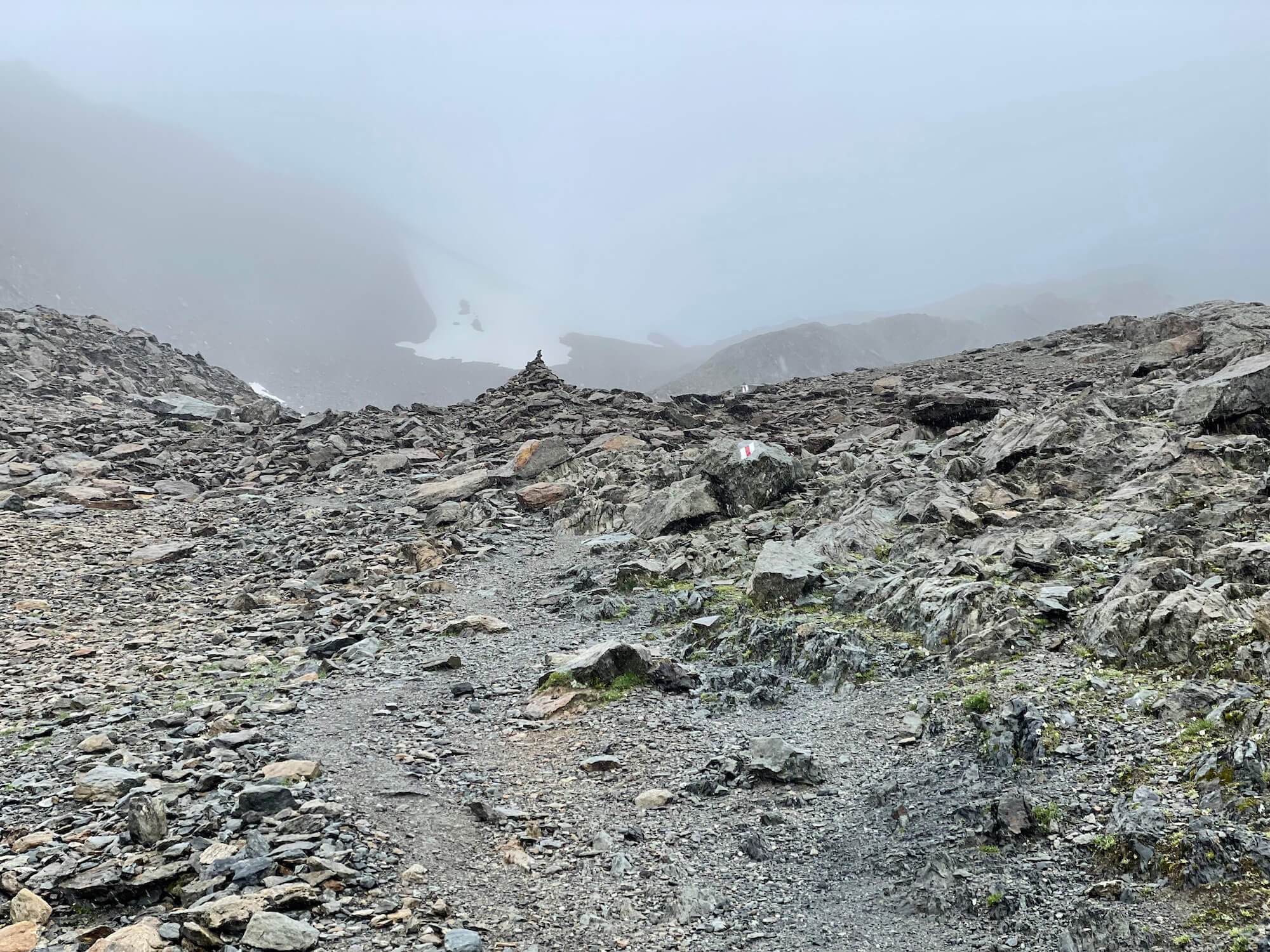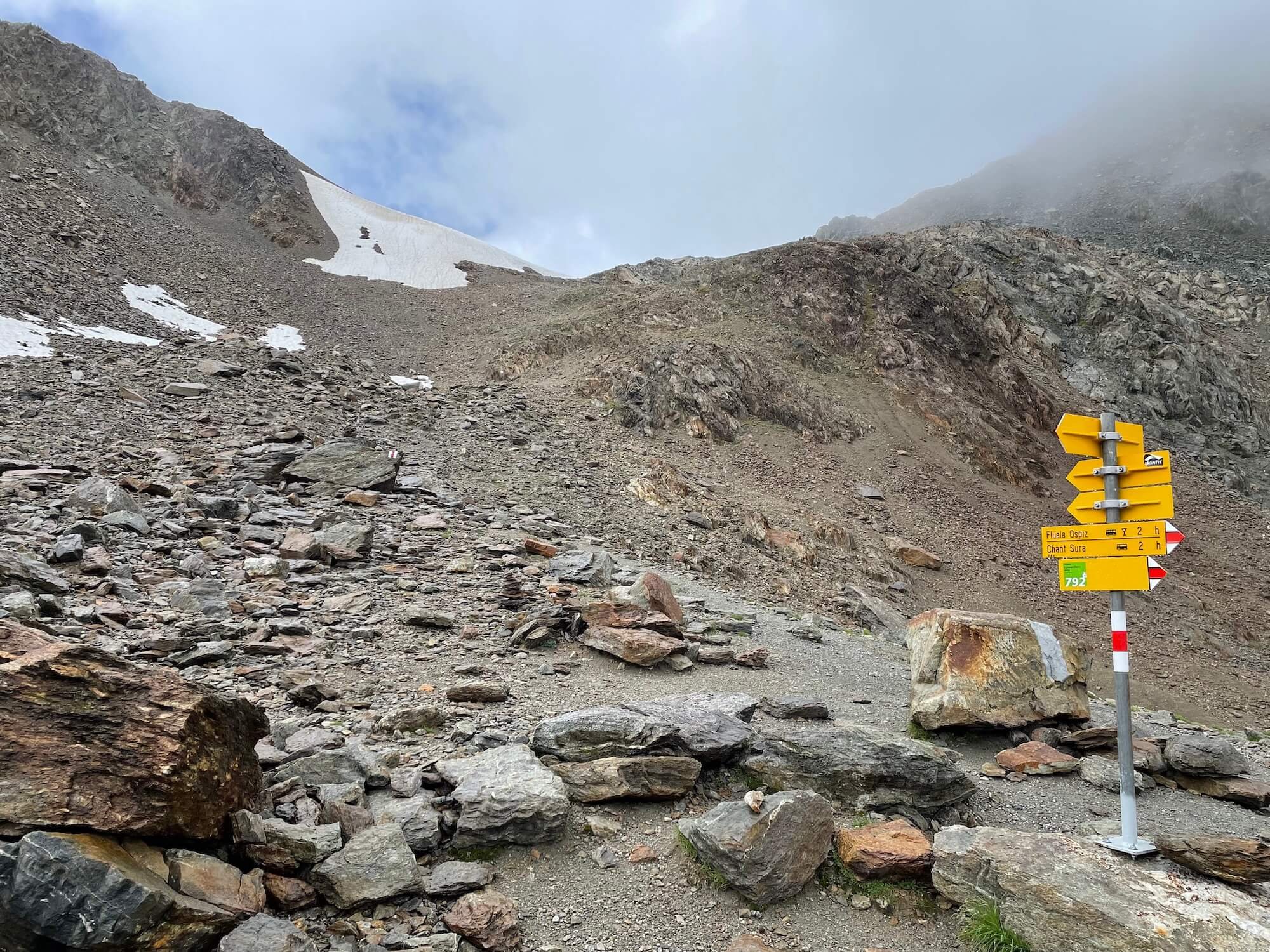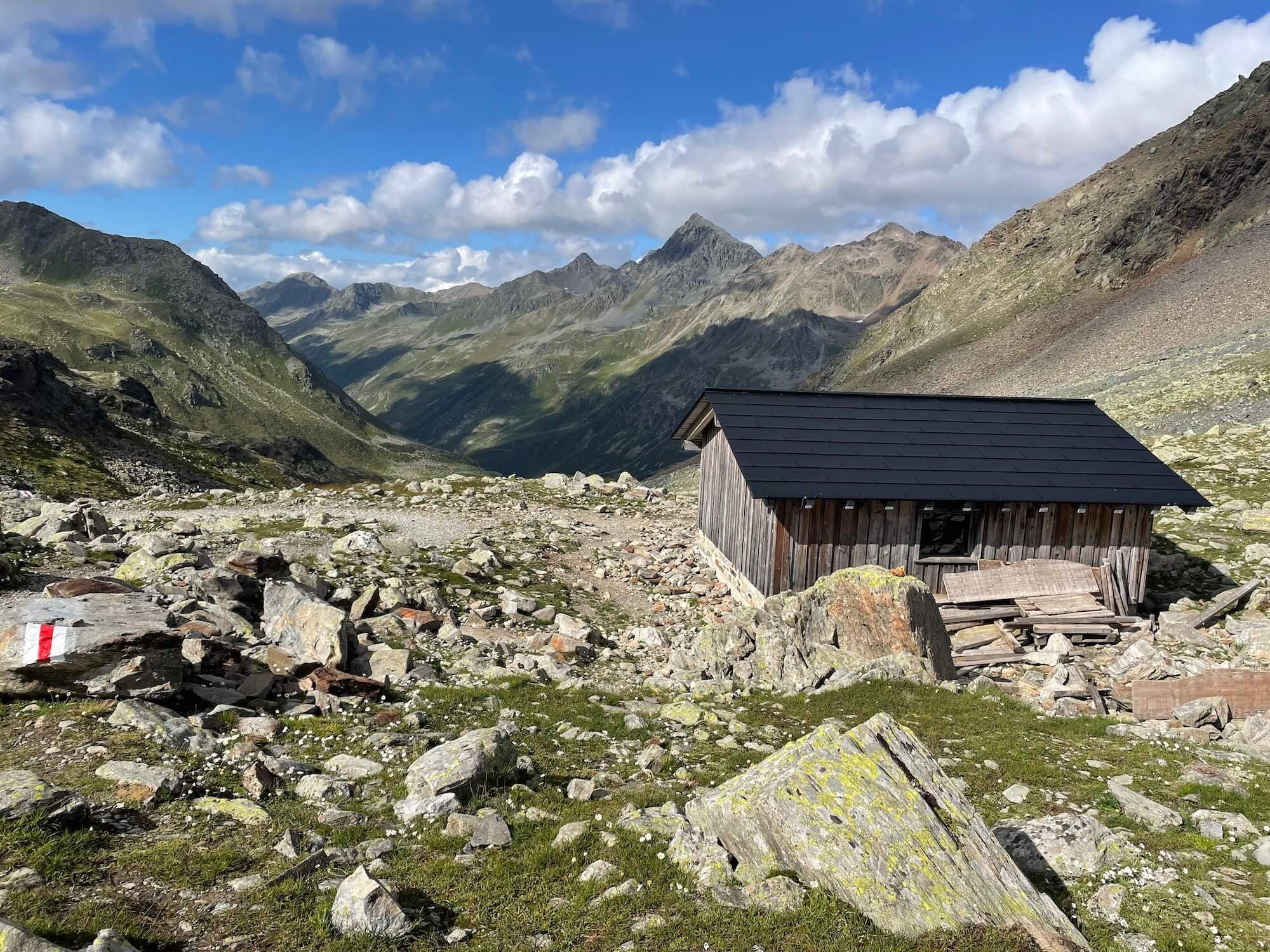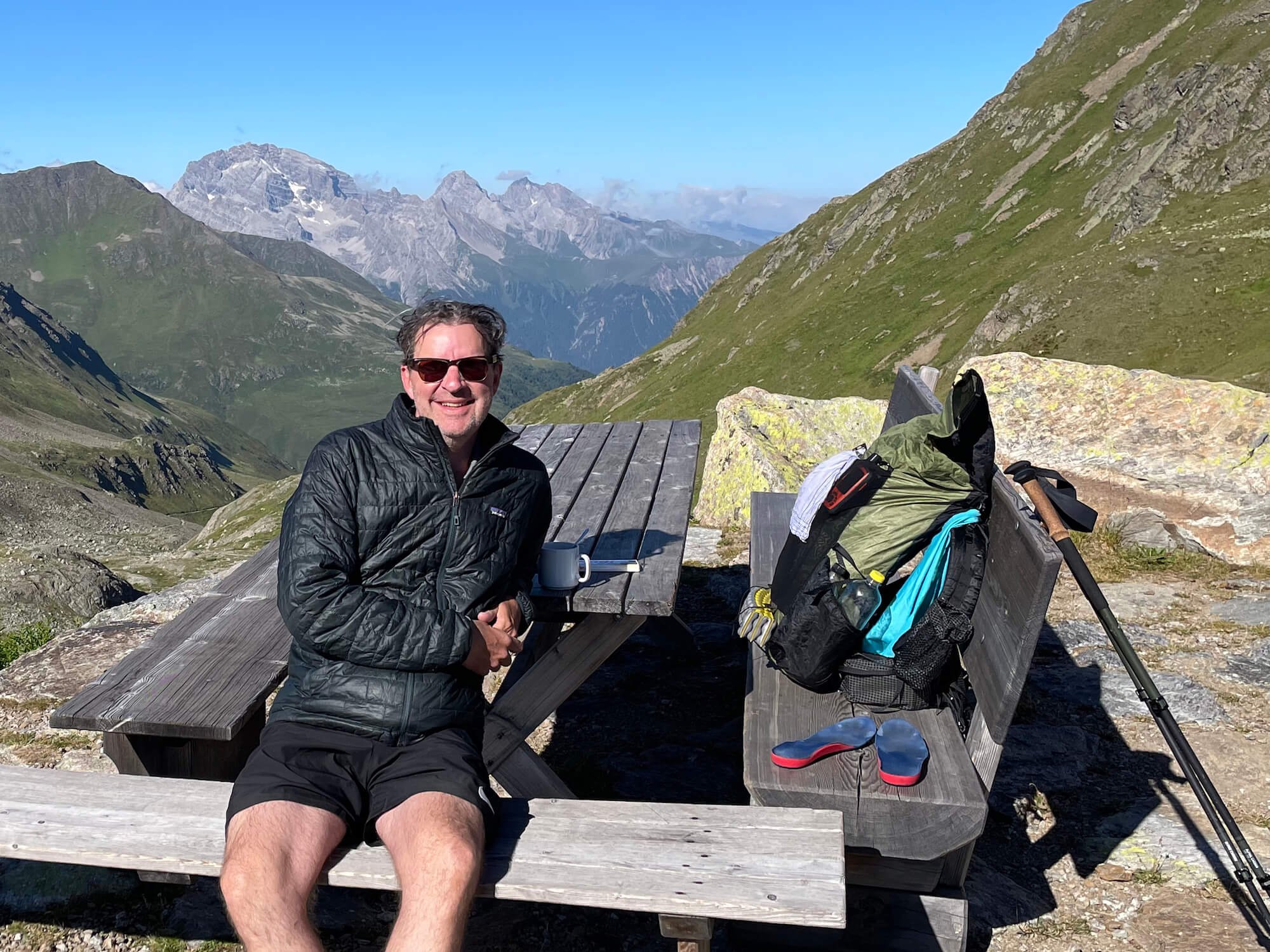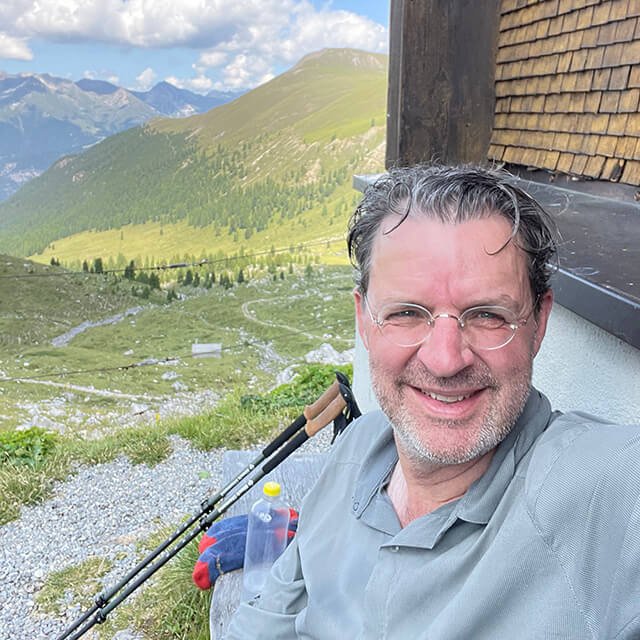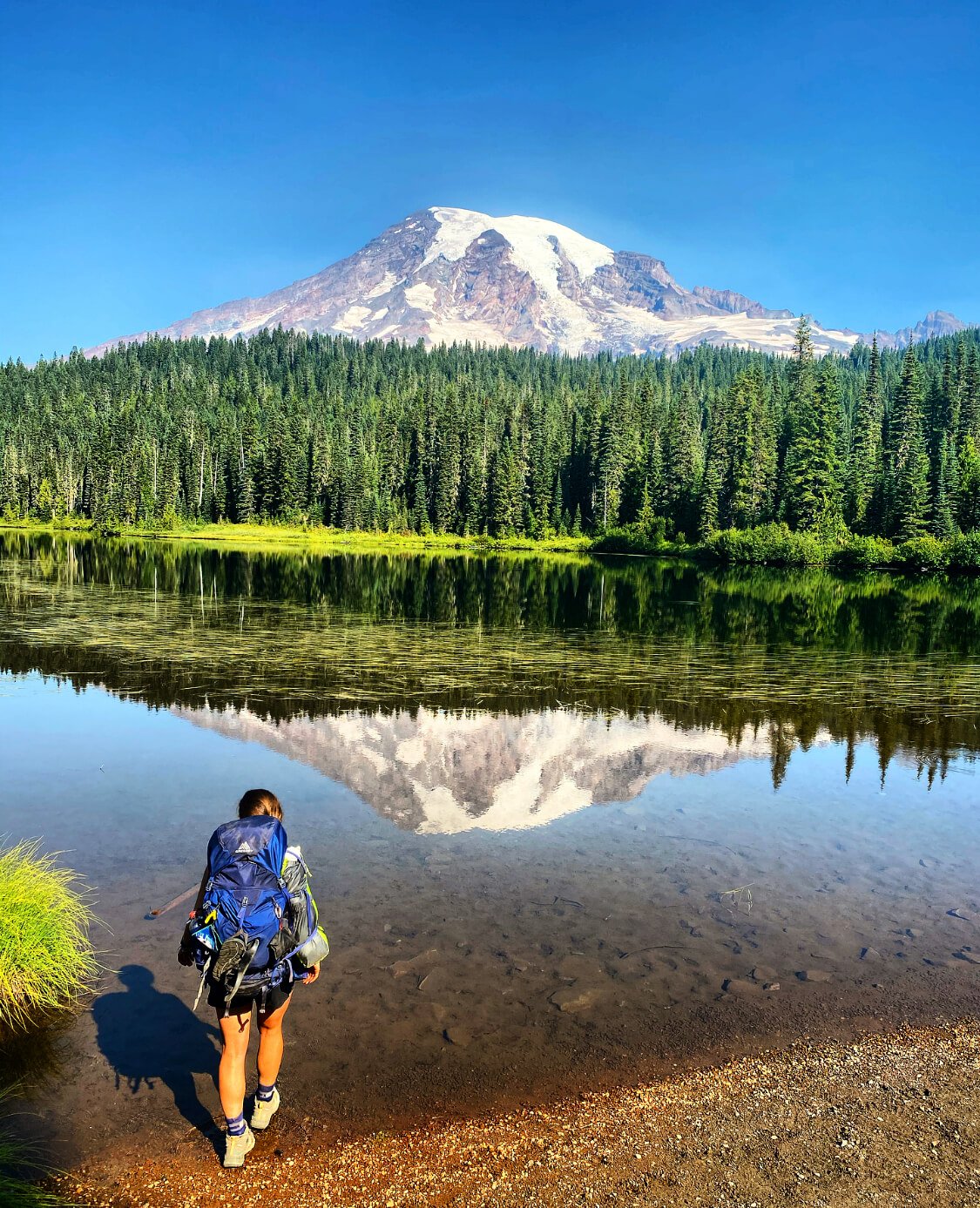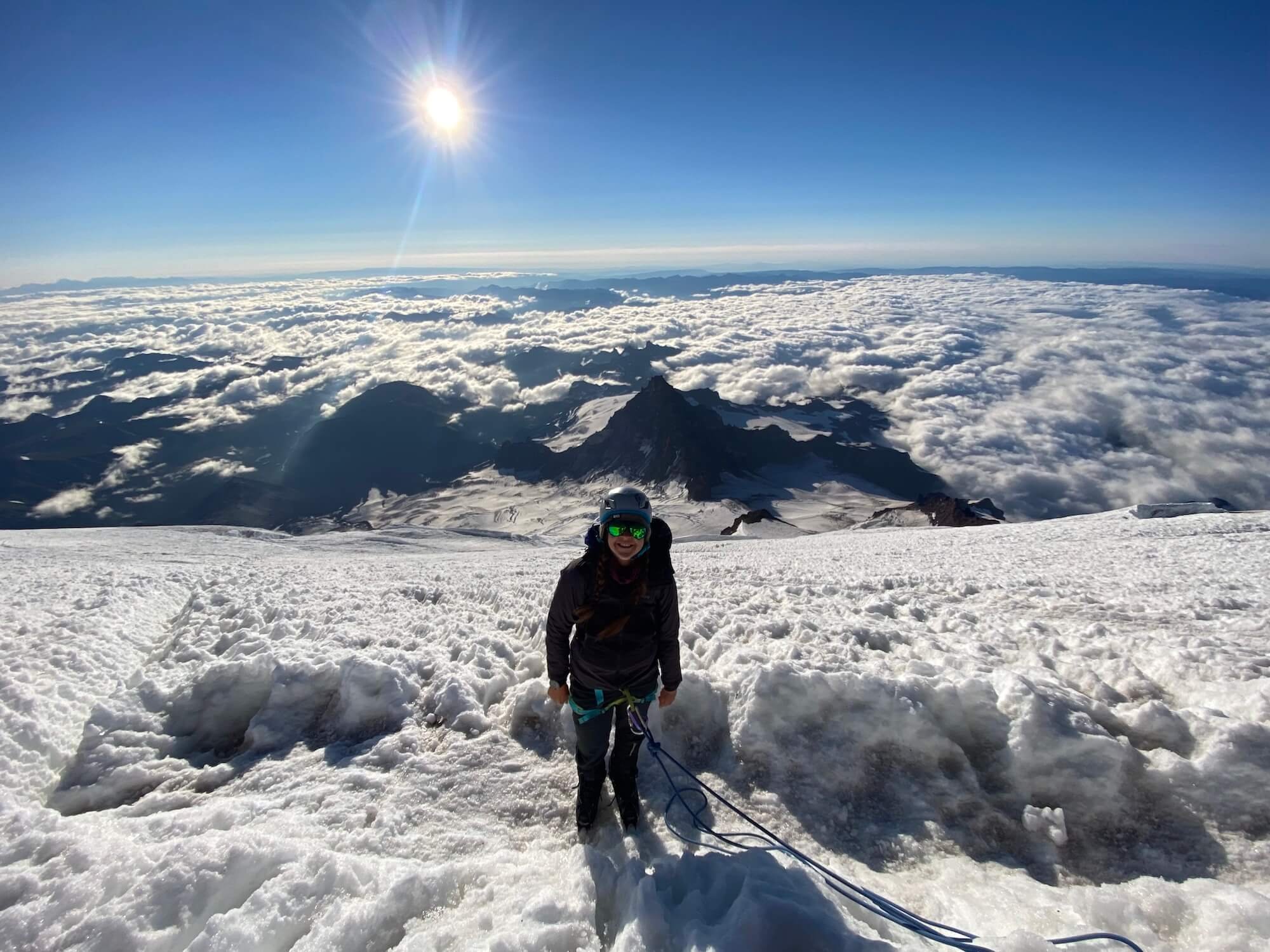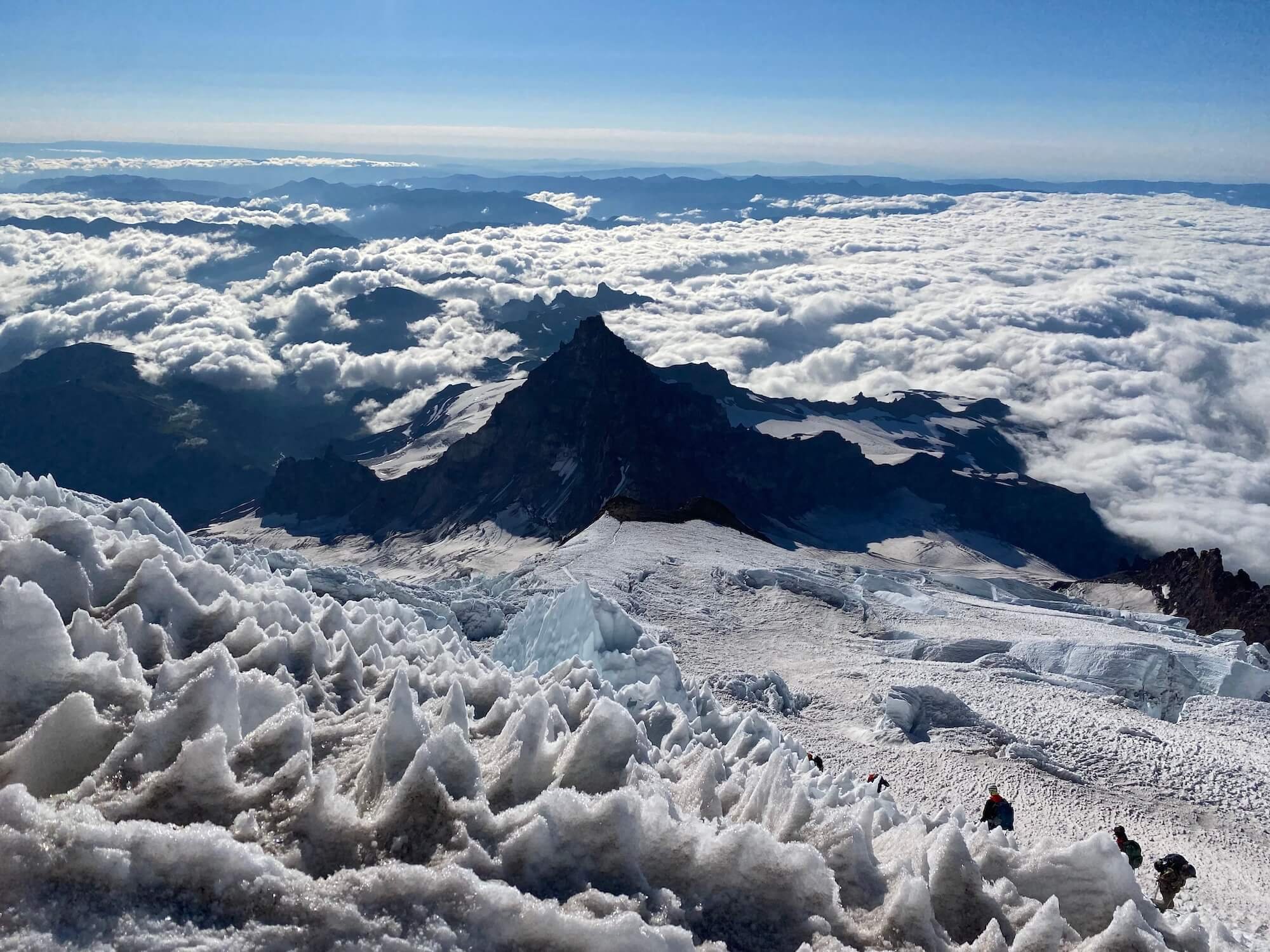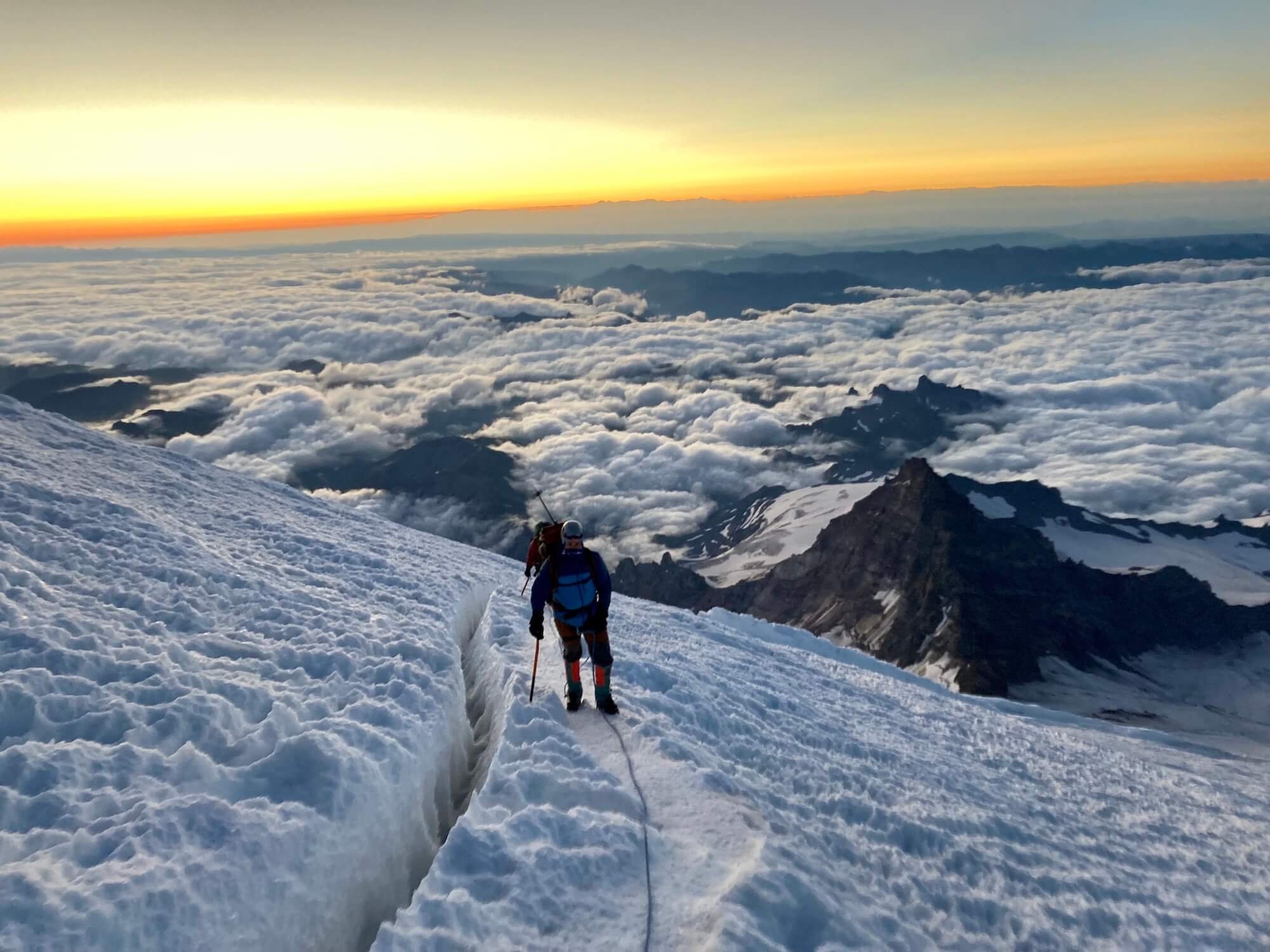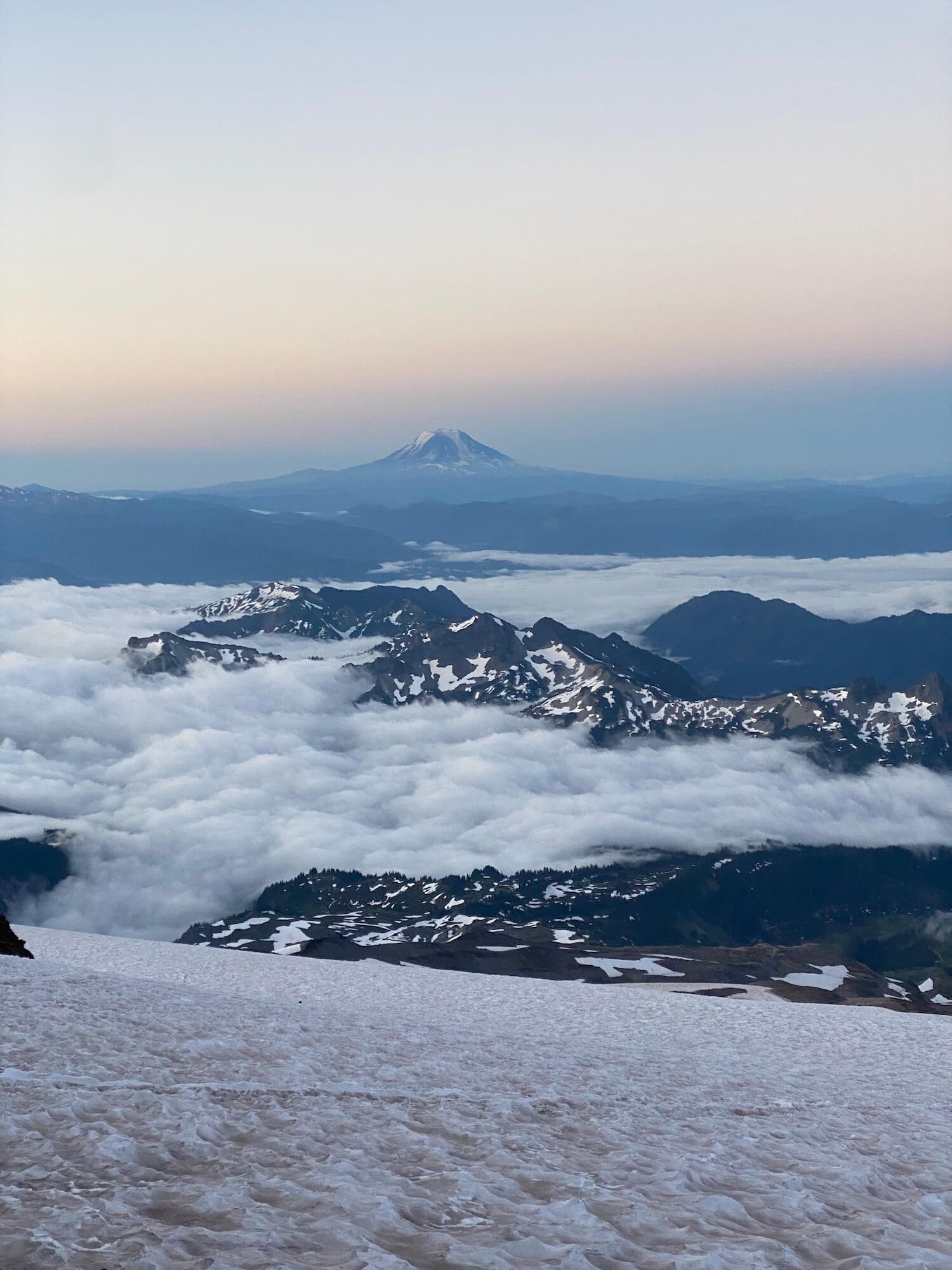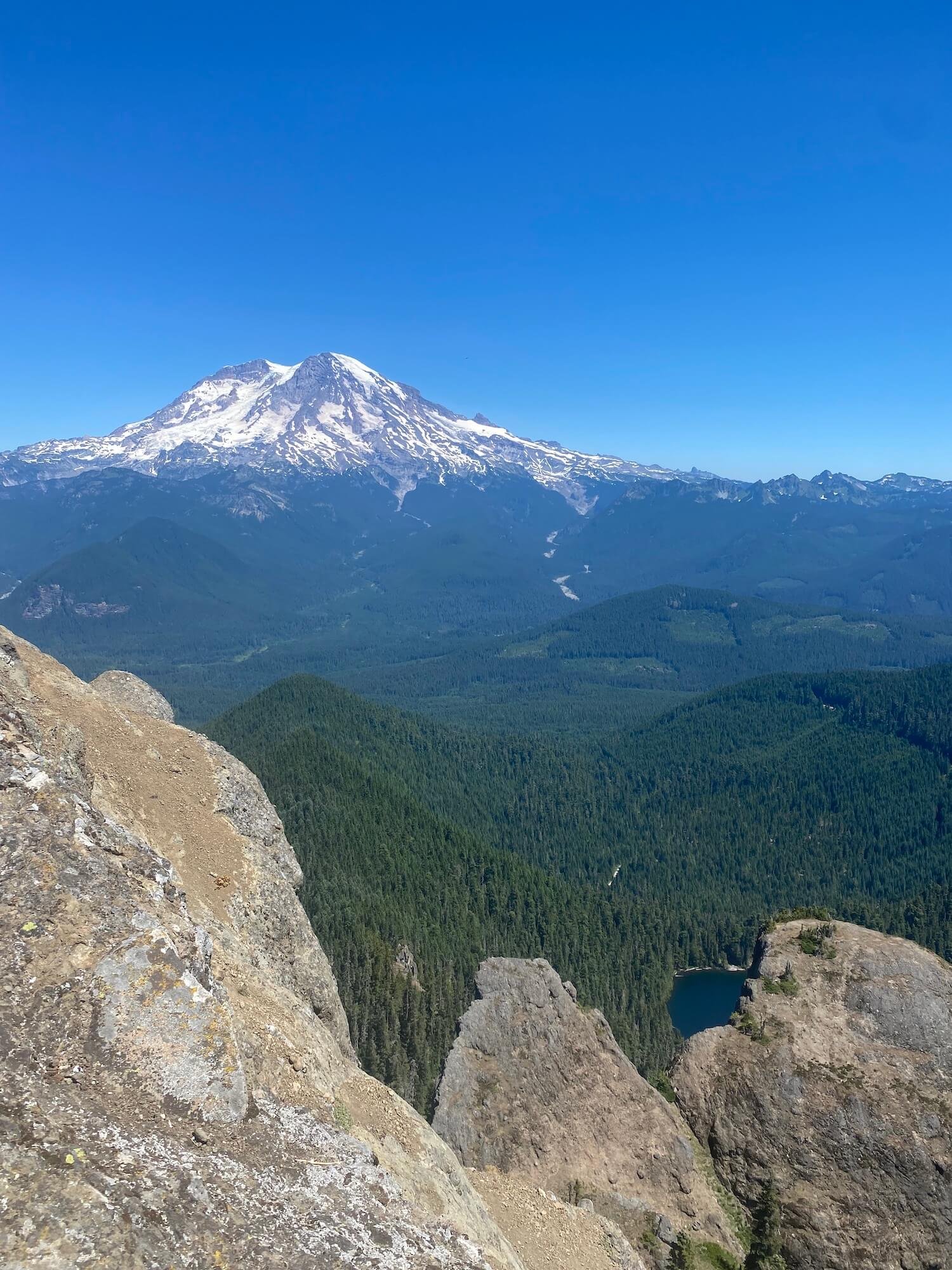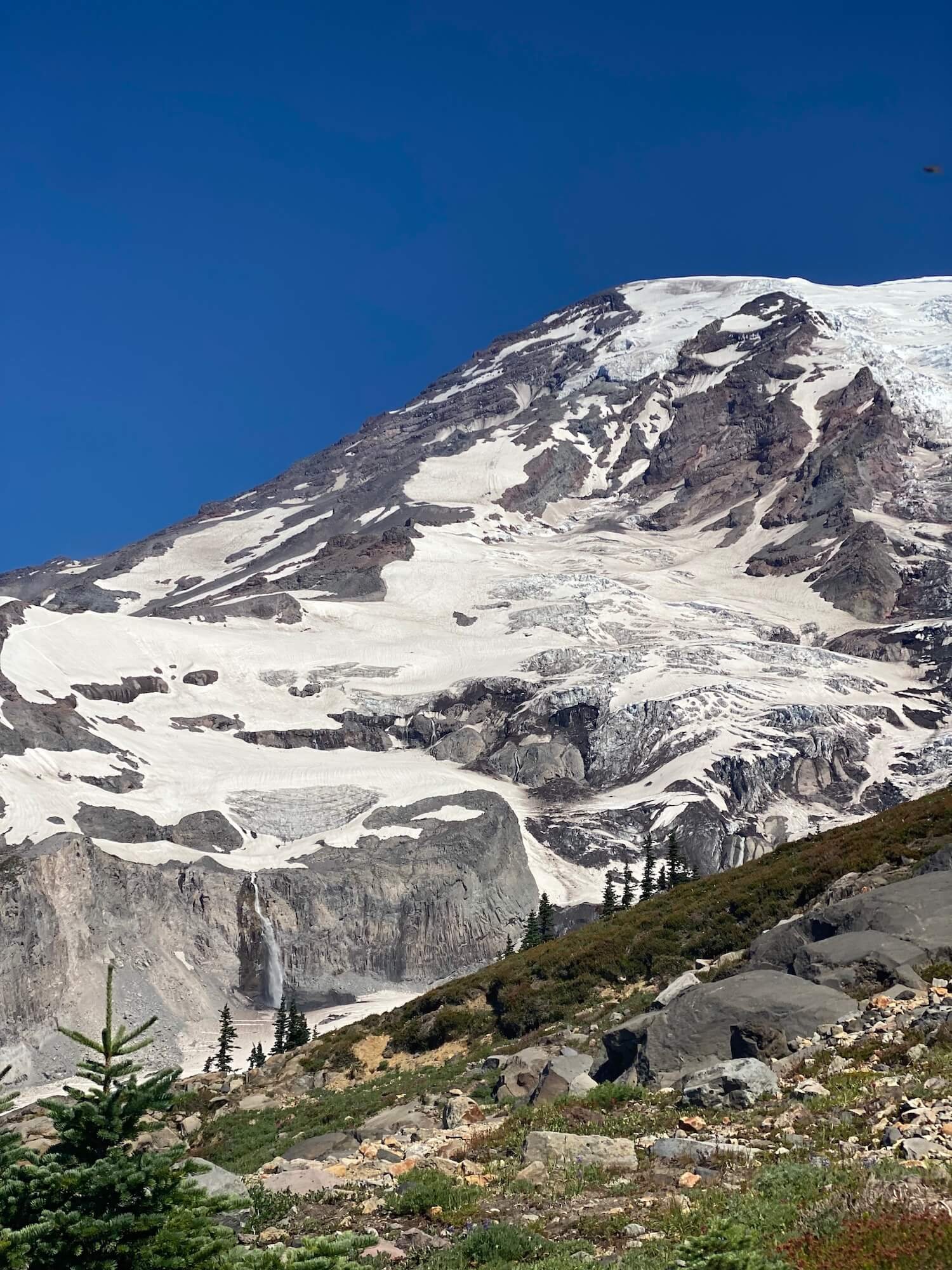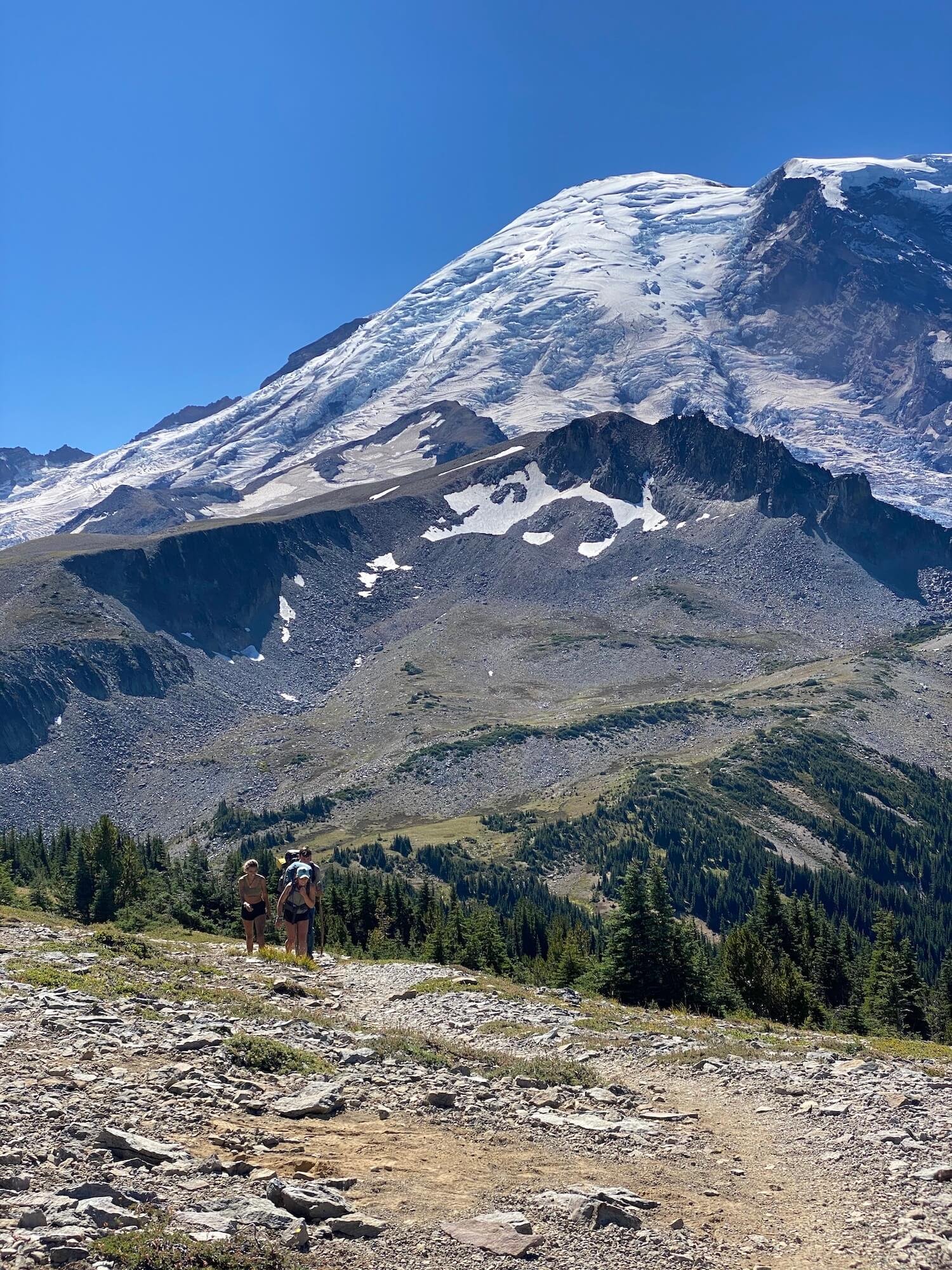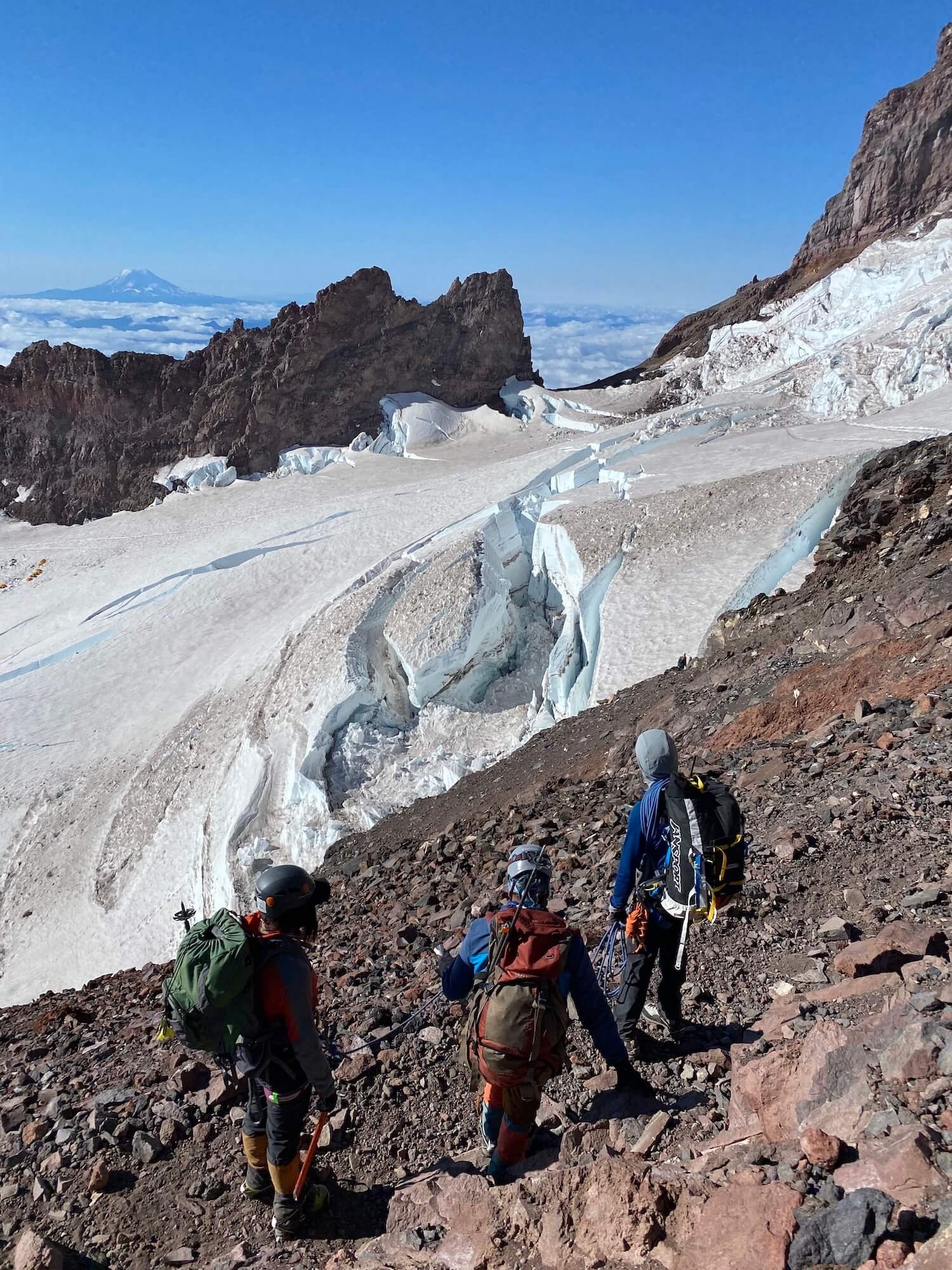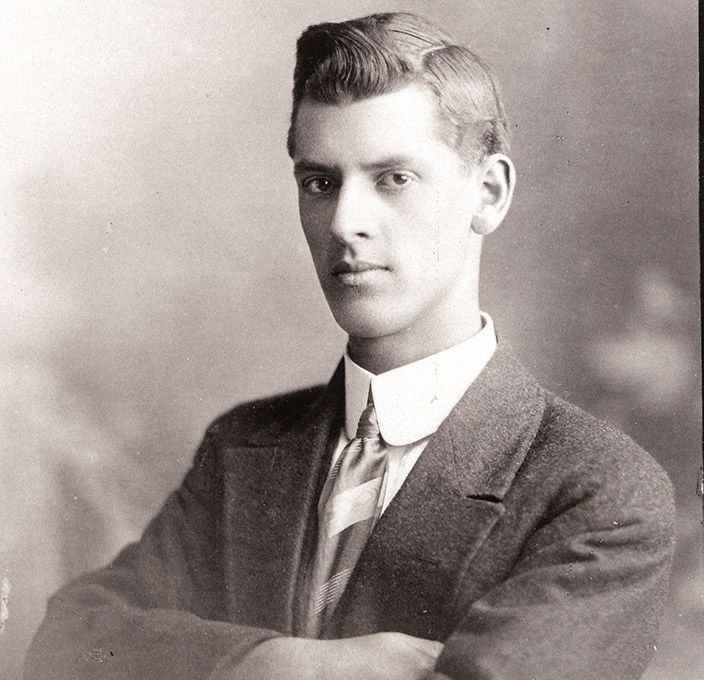Are you thinking of hiking in the Alps with kids? Read Sara’s story of taking her son to the Alps to complete the Tour du Mont Blanc at the age of 8 and the Walker’s Haute Route at the age of 11. Was it easy going? Not all the time. But the encouragement from others on the trail kept him going, as well as their promise to take him to Disneyland Paris when he was finished. Yes, sometimes a bit of bribery is needed!
Finding stillness and connection through hiking
Finding stillness and connection through hiking
Kayla Costigan is an American travel nurse I met while I was trekking solo in New Zealand. We connected over a shared passion for travel, nature, movement, and helping others. We have since hiked together throughout the United States, as well as in Morocco, Portugal, and Prague. I asked Kayla some questions about what hiking means to her. This is her story…
As a kid, my parents would have to drag me to go hiking. We would go to New Hampshire from our small Boston suburb and hike for one to two hours. I remember trying to beat my sister to the top, eating Clif Bars, and only pausing for one minute before running back down.
I then hiked a few times as a young adult. Once, when planning a trip in Colorado with my sister, I remember thinking, ‘these reviews on AllTrails are not right. I could push myself to more advanced hikes and higher peaks’. As sports slowly exited my life and physical feats were harder to come by, I began turning to other things to feel accomplished and focus on, and hiking filled that void.
In early 2020, I was planning a solo trip to New Zealand and Australia for two months. The perk of traveling solo was that I could plan the trip that I wanted. I searched online for the best hikes in New Zealand and learned about the Great Walks. I was hooked. My first choice was the popular Milford Sound Track, but it was sold out for my dates. The second was the Kepler Track. The hike was for four days and three nights. Woah, overnight hiking? I hadn’t done anything like that before. I wondered what it would entail? Would I sleep in a tent? What gear would I need to bring?
I signed up for the trek on Christmas eve, as my family watched Harry Potter next to me, complaining about the light from my laptop. I smiled to myself as I closed my computer after reading the confirmation email. I was ready to take my hiking to the next level. I would be doing the Kepler Track.
I learned that I was not sleeping in a tent but in hiker huts tucked into the mountains. I had never done anything like this. I made it to the start of the trek after countless Google searches for flights, buses, and hostels in these ‘Southern Alps’.
The day was finally here. With my bag packed, I stood at the permit office in New Zealand. “You should not do the trek!” the woman at the desk said as she judged the abnormally small size of my pack. “The forecast is for inclement weather, the most rain New Zealand has seen in 100 years. There is a risk of mud-slides”. I had traveled so far to do this hike and had my heart set on it. I had been running every day to train for it. I needed it.
I thought to myself, ‘okay, I will go to the first hut, if I feel unsafe, then I just turn around and hike out, as simple as that.’ I felt prepared with enough food and water to last me a few days and I had plenty of layers to keep warm.
I followed my gut, the same one I have learned to listen to and trust. I entered the trail alone with hours and miles of hiking ahead of me. I can do this, I know I can. I watched my cell phone service bars dwindle with the sunlight. The clouds were upon me but I kept moving forward. I realized that I had never been alone in the mountains before, let alone mountains on the southern island of New Zealand. It was gorgeous.
I started seeing glimpses of giant fjords through the clouds, proof of my elevation gain and an inspiration to fuel those endorphins and tolerate the raindrops beginning to fall from the sky.
For one of the first times in my life I felt peace and was comforted by the silence and solitude. I was no longer afraid but energized, walking step by step toward my goal, and knowing that I had got myself to this moment. I felt a sense of calm that would help shape many future decisions. Instead of only chasing the highs, the excitement, and the peaks, I started seeking out quiet sacred moments with my best friend: myself.
Throughout the trek, I was sometimes alone, but at other times I connected with hikers on similar, parallel journeys who, like me, appreciate the power of nature and the peace it provides. Yes, I did make it to the first hut that day! After four 4 days of walking, I completed the Kepler Track; hiking through record rainfall, finding direction through nature, both presently and for my future, and connecting with new friends along the way.
At that first hut, I met Sam, a hiker from Seattle who was also trekking and traveling solo, seeking peace and connection with nature to help her along her personal journey. People you meet on the trail are special and they stick with you. You create a bond that is unique to the disconnection from the rest of the world, something that is hard to come by in our connected world. The trail provides this space.
Since meeting in that hut in New Zealand, Sam and I have hiked in 4 additional countries, completing a road trip through the National Parks of Utah, USA, on a guided trek through the Atlas Mountains in Morocco to the second highest peak in Africa, up the coast of Portugal on The Fisherman’s Trail, and on a day hike outside of Prague.
Any conversation on a trail is pure, whether it is with other hikers or with yourself. It is my favorite place to get quiet and tune into my gut. Hiking is where I am the most present and able to fully listen with the intent to learn and share my own wisdom and experience in return. The presence that I found on the trail is something I now try to bring into the rest of my life.
I now seek out other ways to shut down my mind without needing a flight across the world or an epic adventure. These are things I can bring into my everyday life. I fell in love with meditation and recently became a certified meditation teacher. I find quiet moments in my days to be still, feel present, and take it all in. I practice yoga, find nature wherever I can, go for walks or runs wherever I am, and drag friends and family to appreciate the power that the quiet of nature provides.
The Kepler Track changed what it is I seek out in life. It made me crave peace, a type of peace that is easily found in nature, and it brought amazing people into my life. It helped me begin to explore the body mind connection and the power that exists between the two.
Hiking is a form of moving meditation to me, and whether alone or with others, it is the time I use to check in with myself and where I am in life and on my journey. It is a time where I find a sense of stillness in motion and that in turn brings me peace.

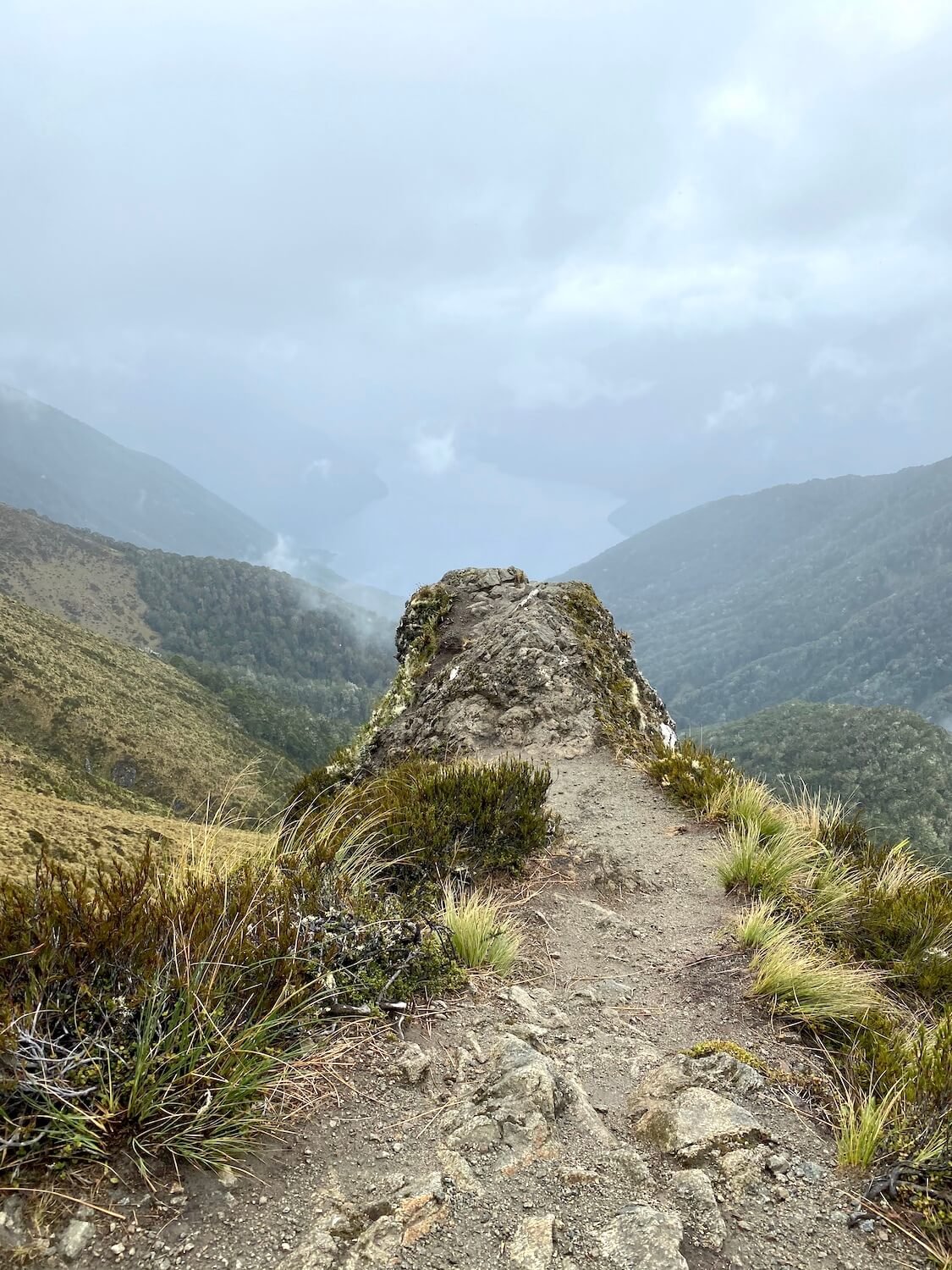
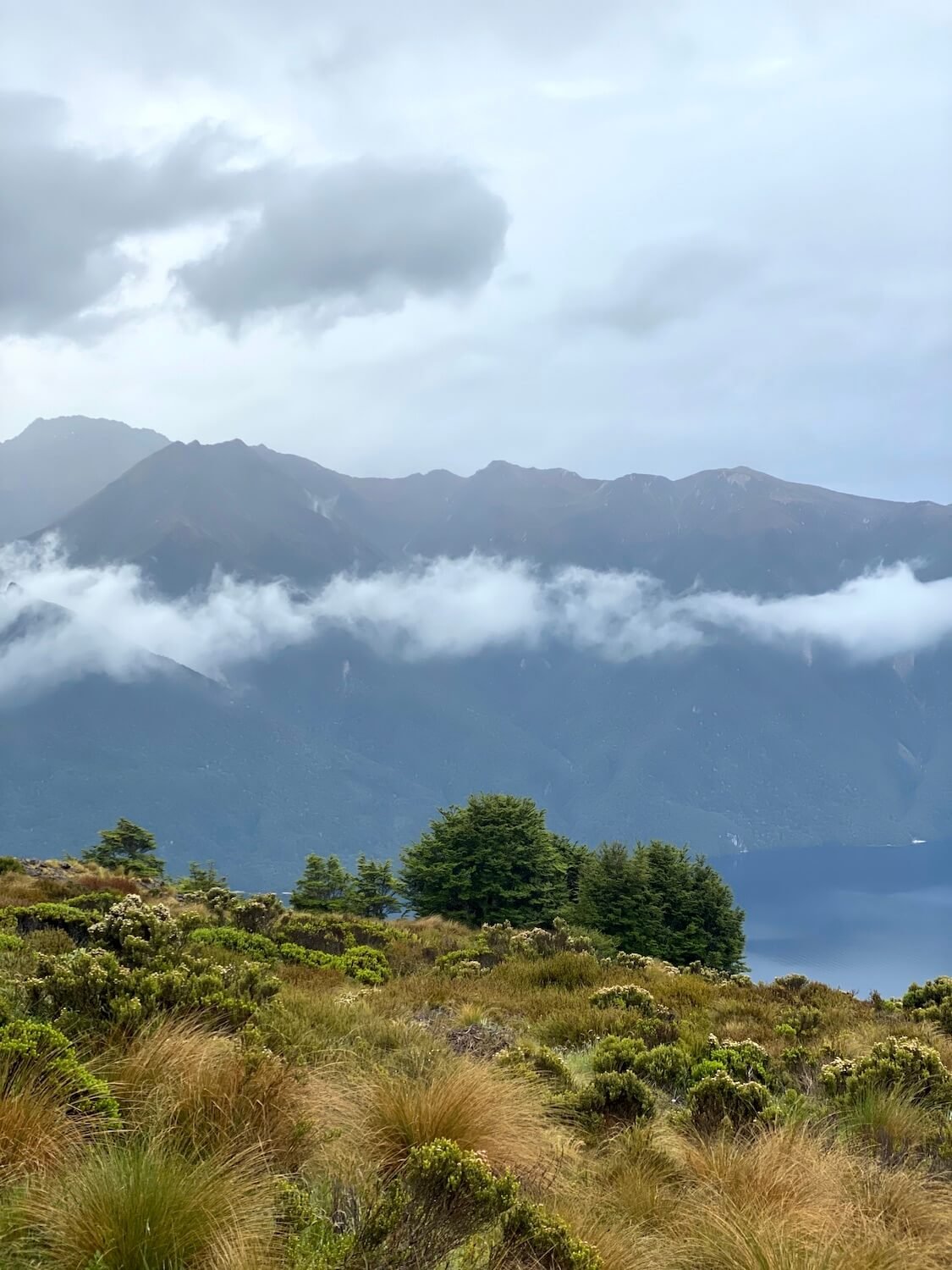
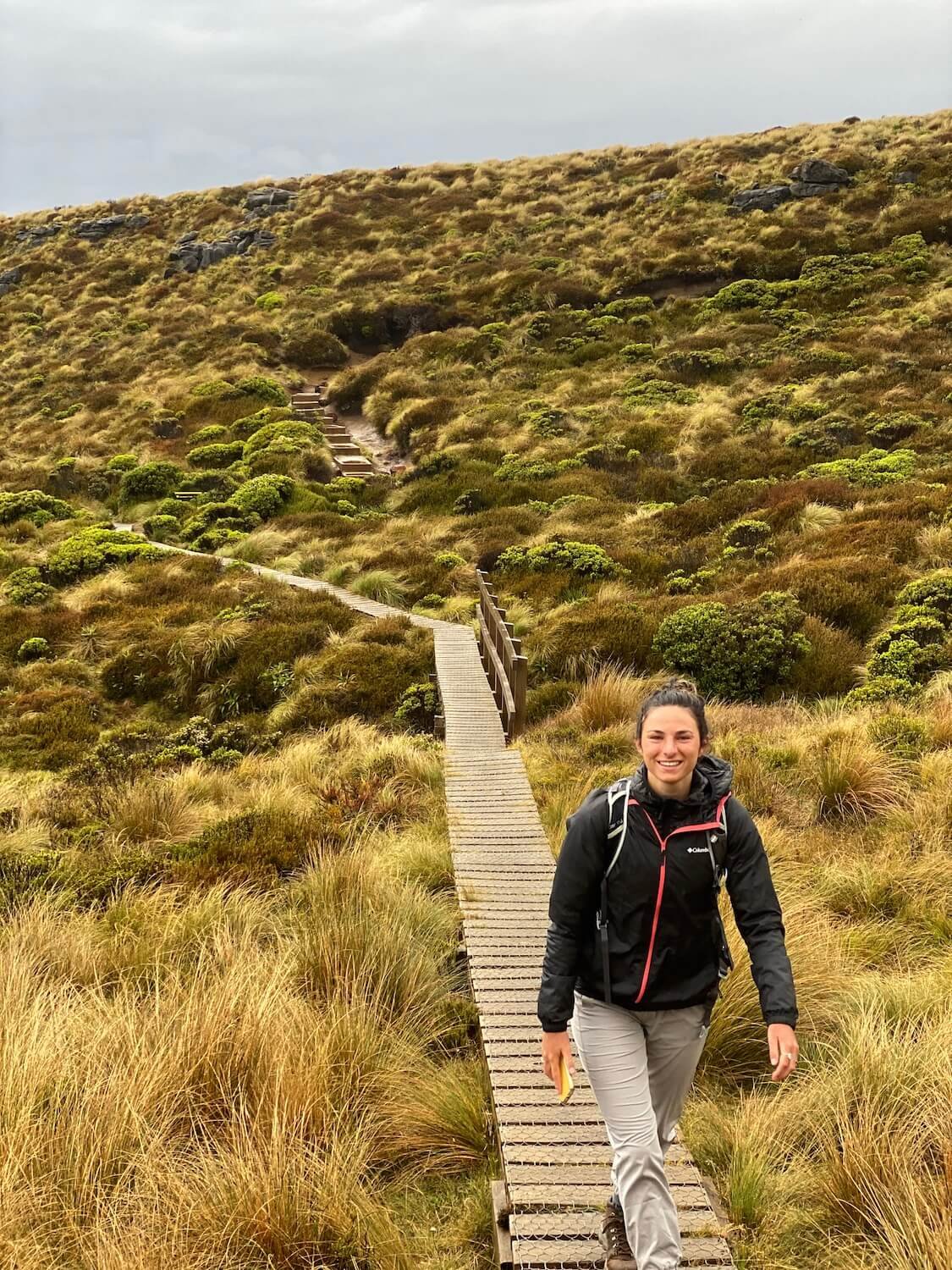
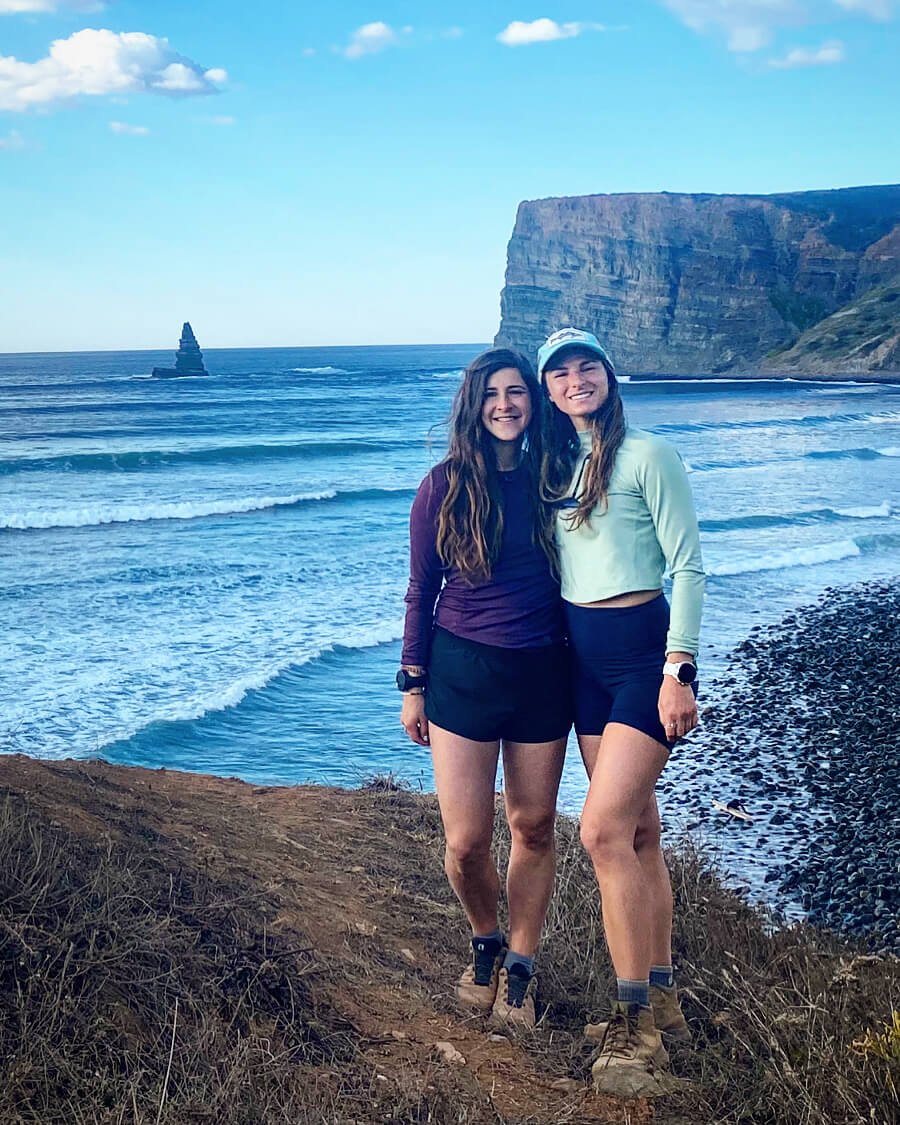
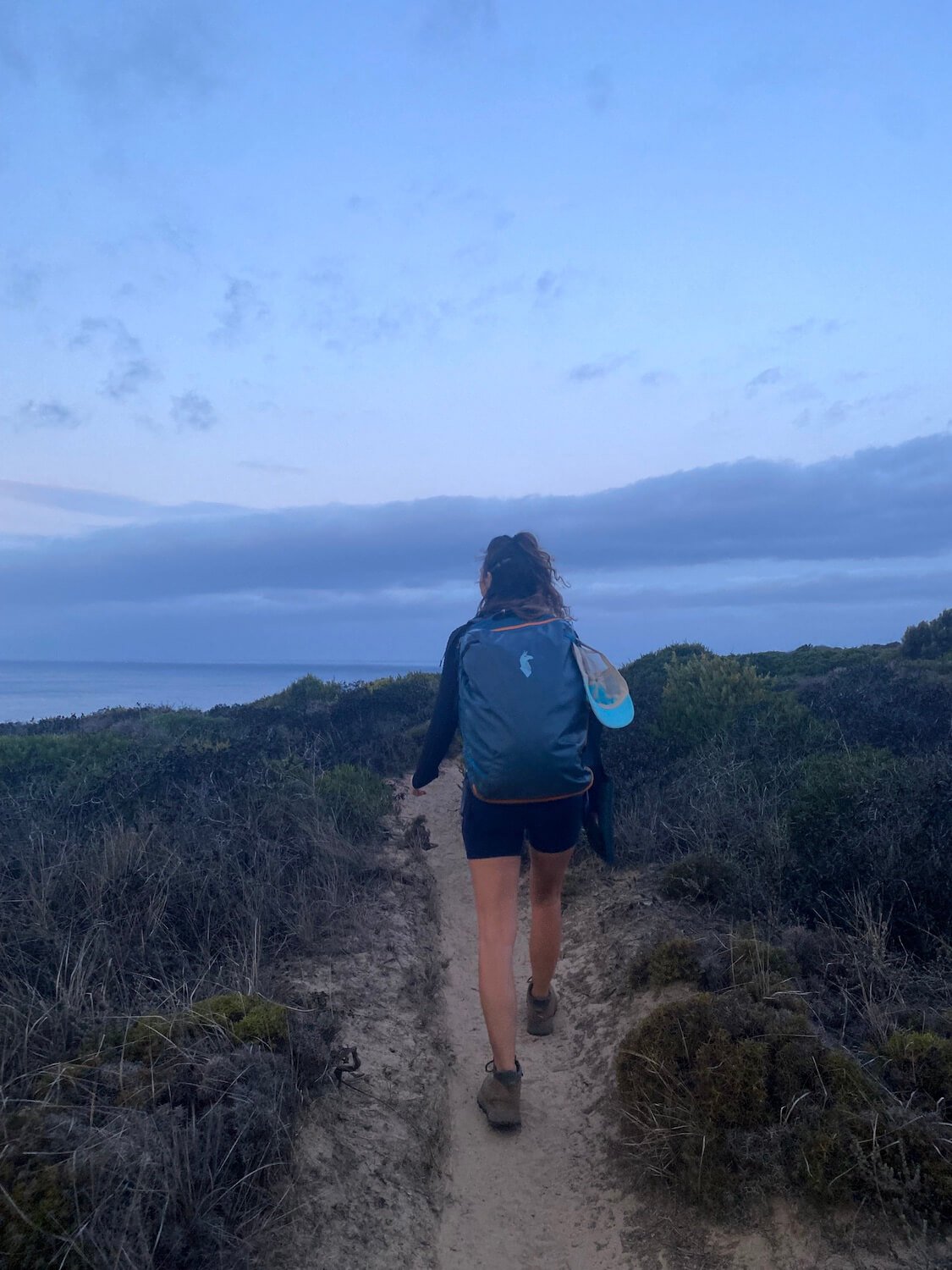
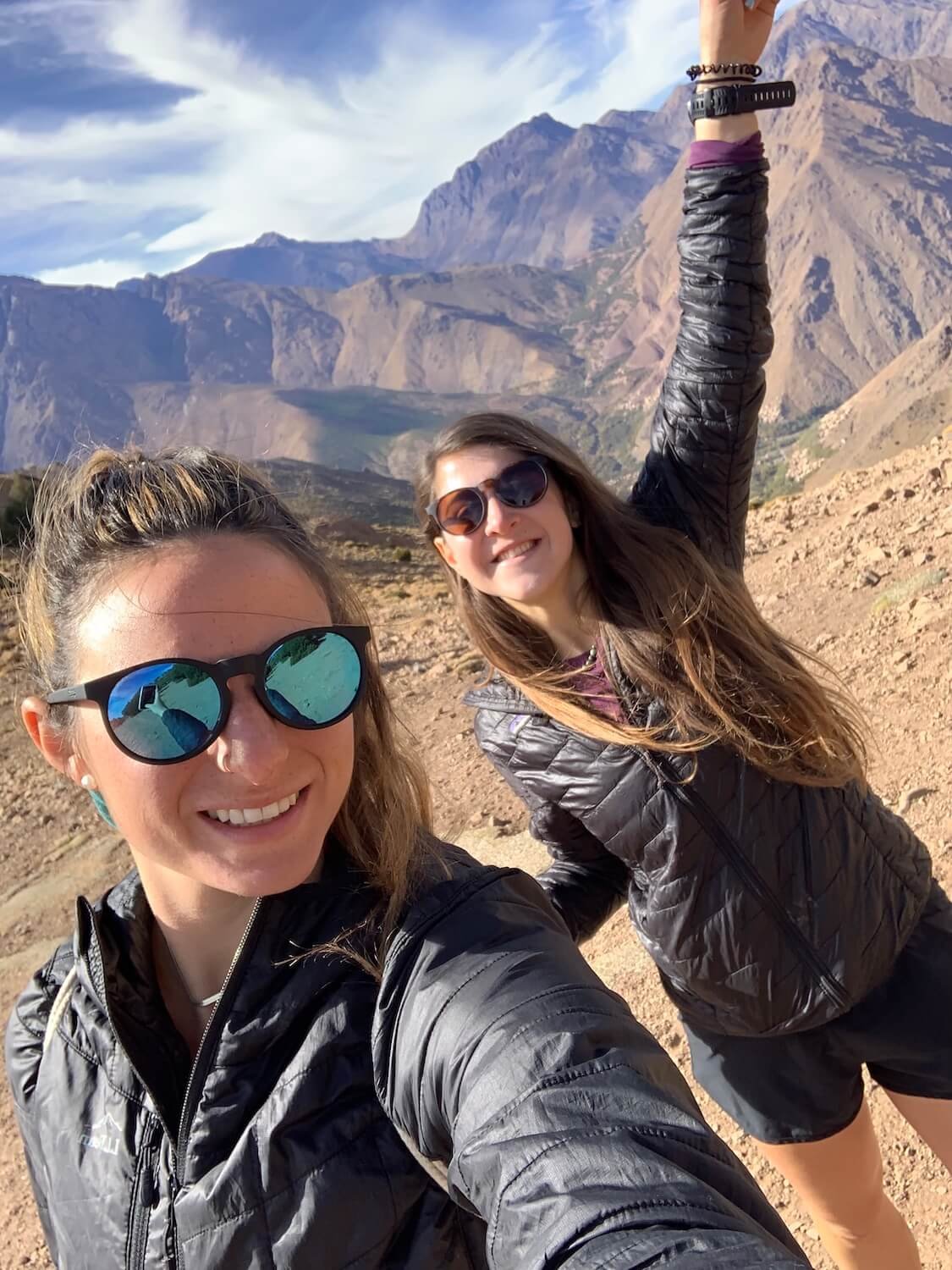
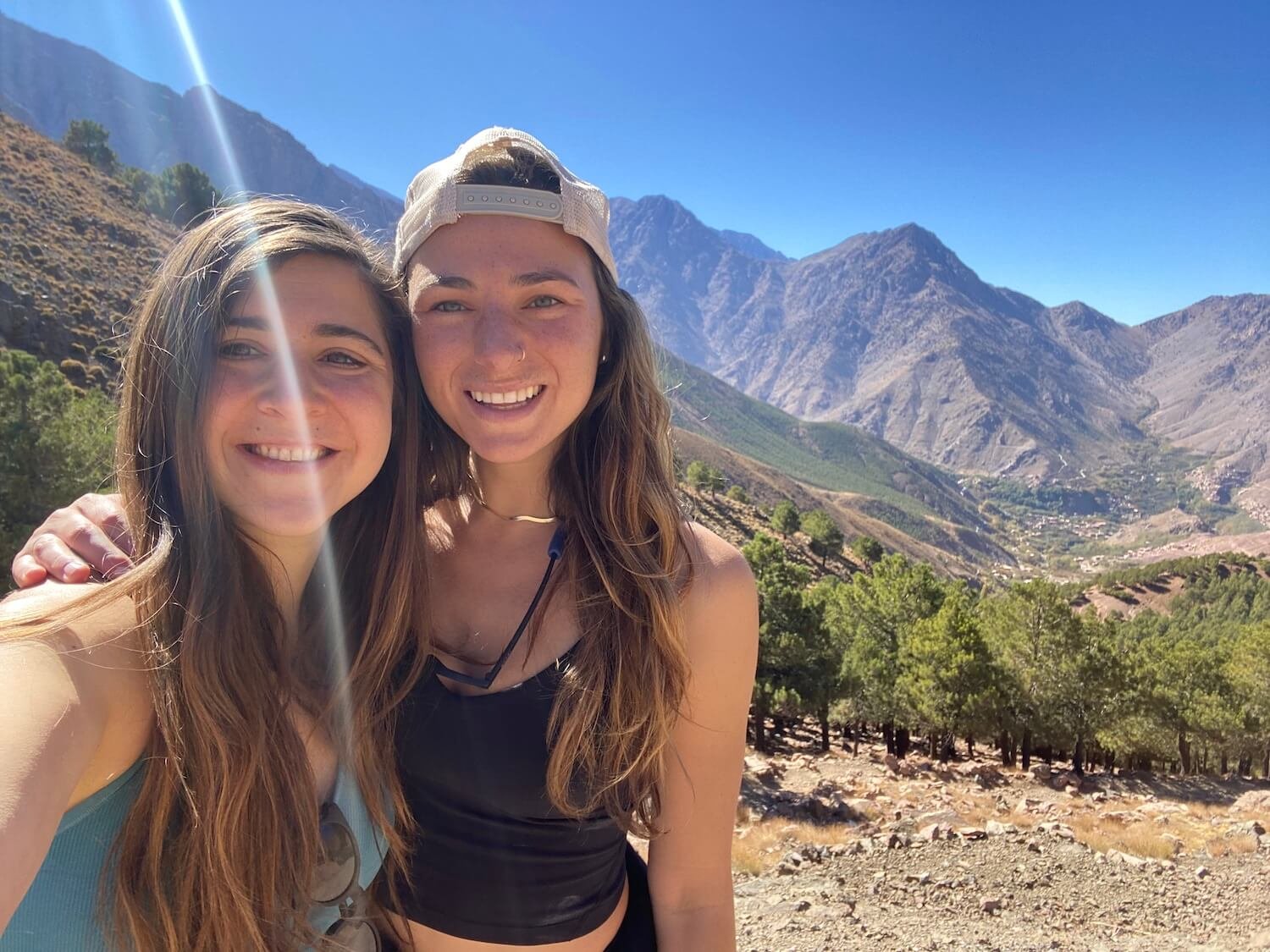
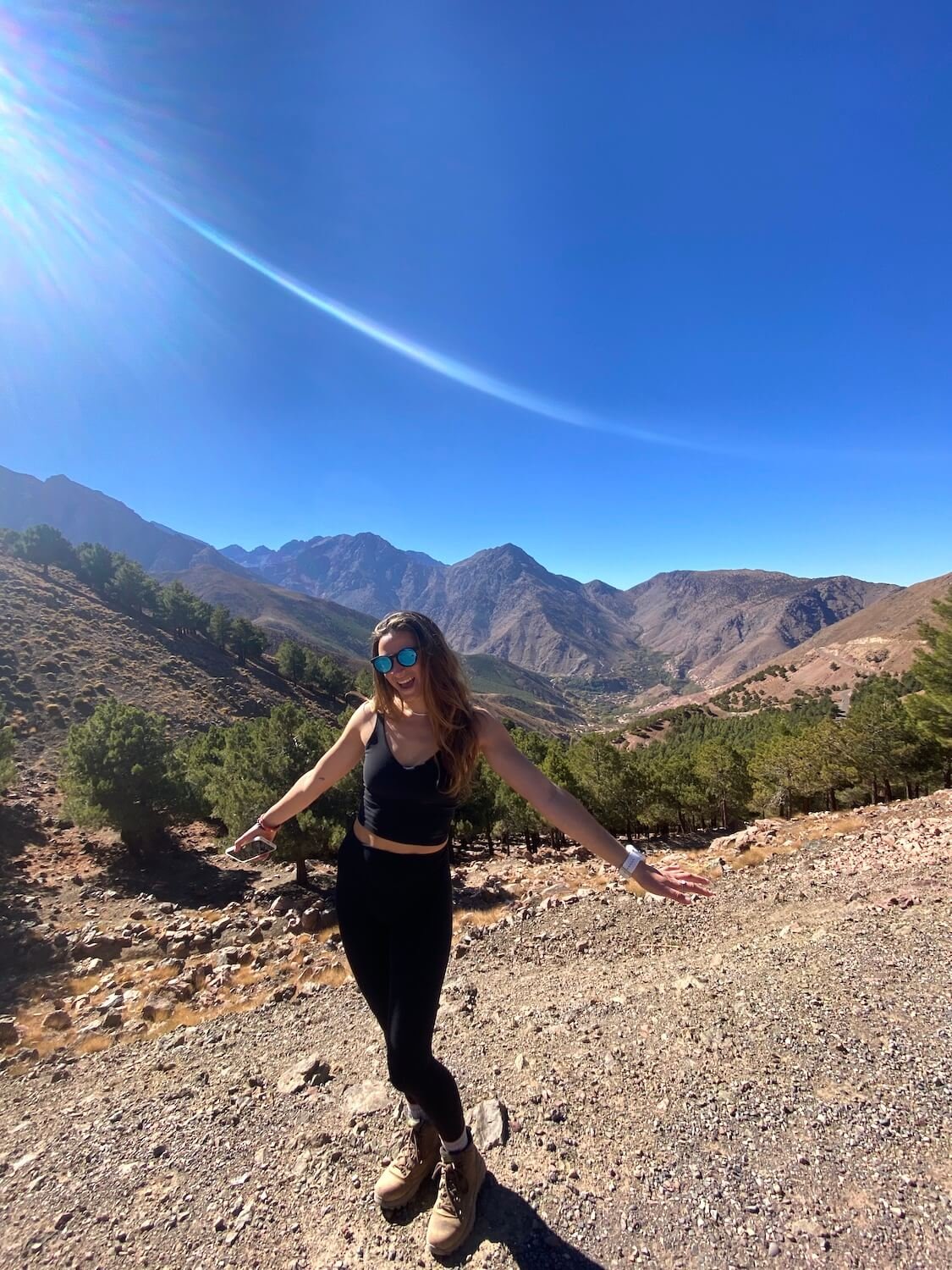
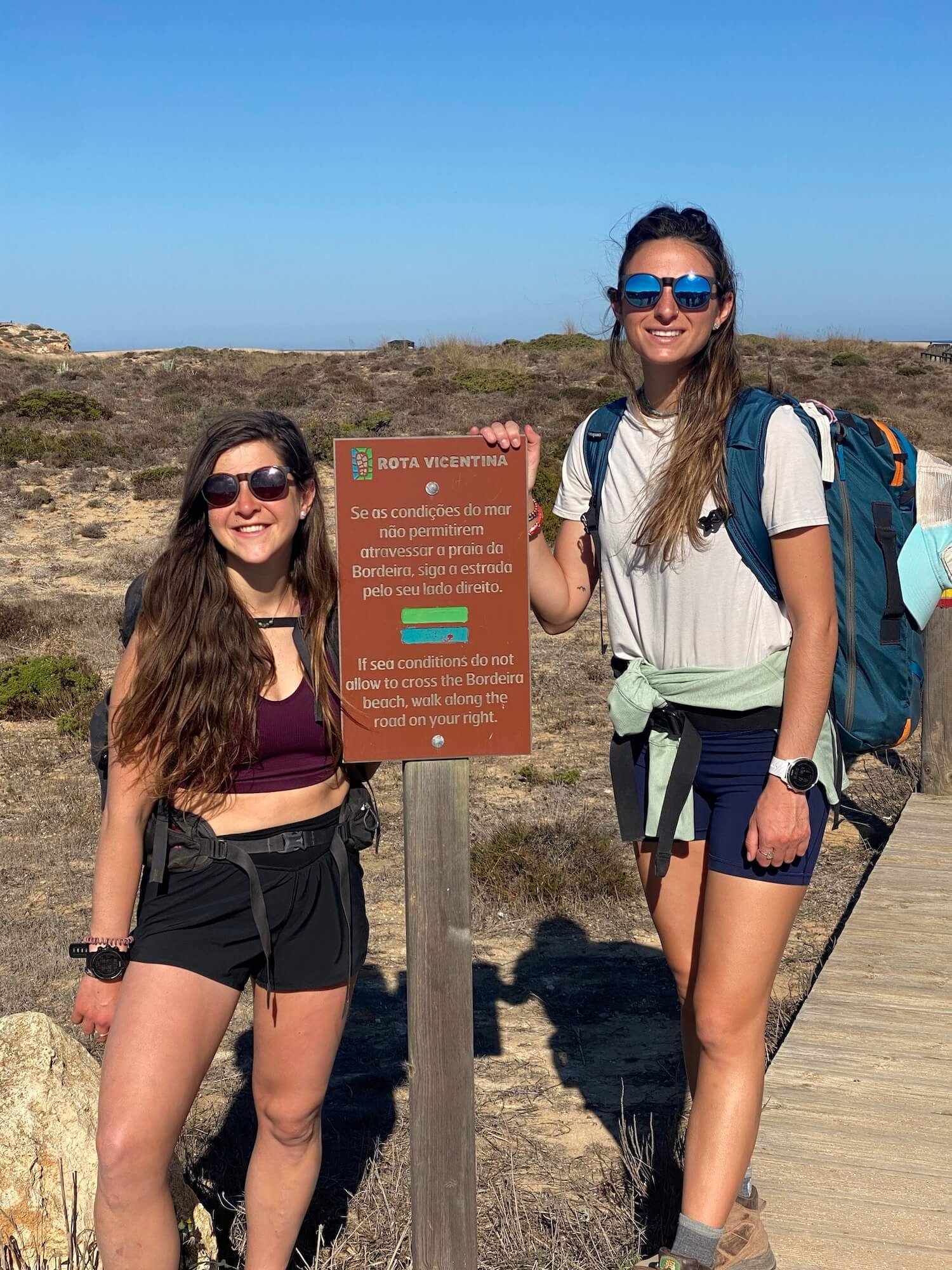
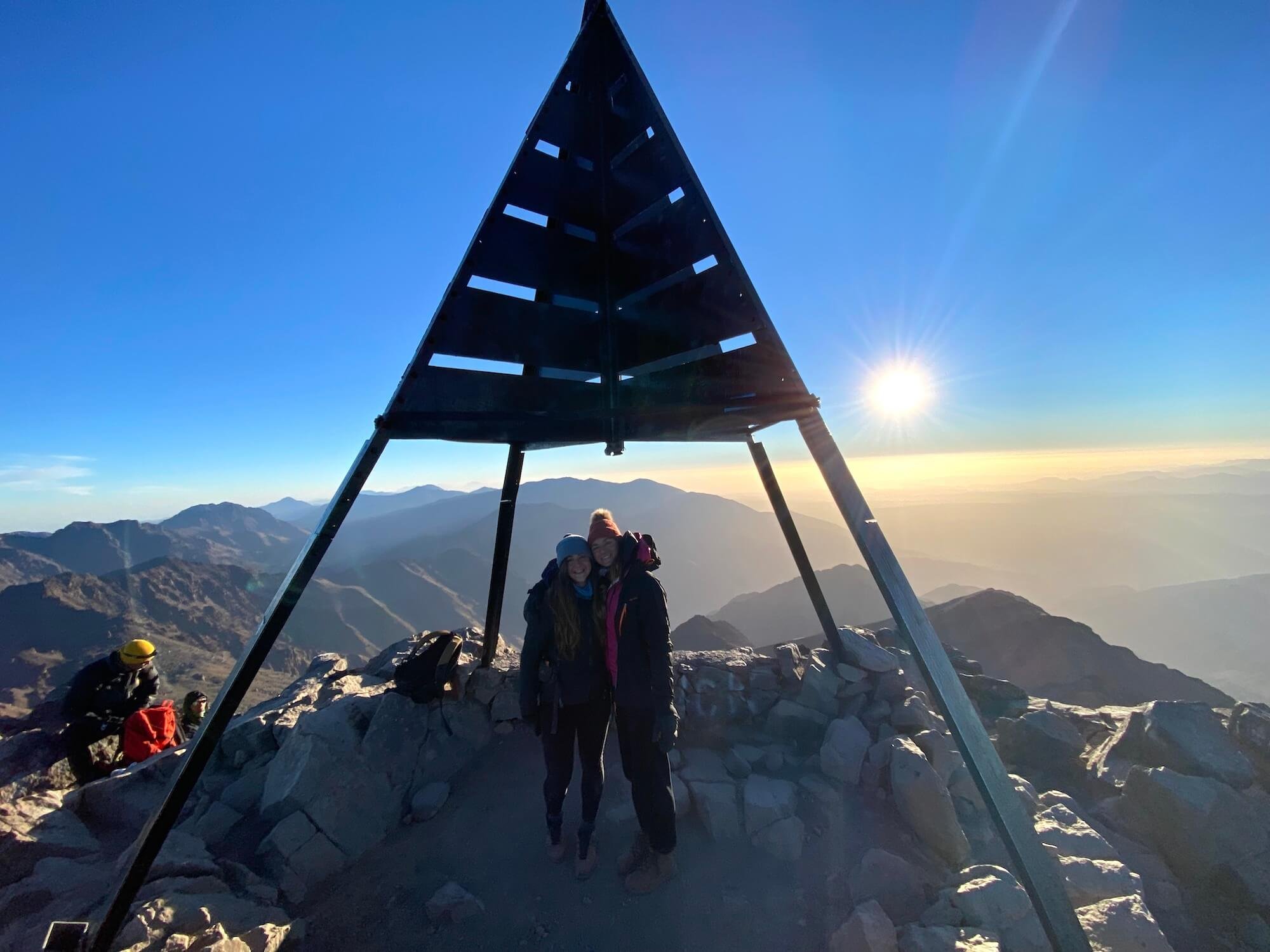
Author: Sam Goldklang, USA
Sam is an everyday adventurer who resides in Washington State, USA. She has completed the Wonderland trail and summited the 5 tallest peaks in the lower 48 states, including Mt Rainier. Sam has hiked around the world with some of her notable trails being: the Tour Du Mont Blanc in the Alps, The Kepler and Routeburn tracks in New Zealand, the Salkantay Trek in Peru, the Mt Toubkal trek through the Atlas Mountains in Morocco, The Fisherman's trail in Portugal, and Trolltunga in Norway. Sam spends her days working as a Pediatric Nurse Practitioner and on the weekends she'll be hiking, camping, trail running, backpacking, or skiing around the Pacific Northwest.
Follow her adventures on instagram: @sgoldk
WHO ARE WE?
The Hiking Club empowers anyone to walk the way they want in the wild with personalised self-guided hiking experiences that are easy to find, quick to plan and simple to navigate.
We believe hiking experiences have the power to transform lives. With a growing range of personalised hikes that take into account your preferences, fitness and interests, we give you everything you need to explore the legendary trails of the world!
Forging friendships from Mt Ninderry to The Great Wall of China
Forging friendships from Mt Ninderry to The Great Wall of China
Community Leader Spotlight: Di, Liz and The Adventure Angels hiking group
on the Sunshine Coast, Australia.
In 2015, while in recovery from breast cancer, Di Olson pledged to walk 5 days along The Great Wall of China to raise funds for cancer research. “I’ll do it with you!” was the instant commitment from her best friend Liz Ward. Little did they know, this hike would spark a love of hiking for more than just the two of them.
New to hiking, Di and Liz were aware of the challenges of the 5 day hike they had planned nearly 12 months away. With difficult access to parts of the trail, some less well-maintained sections, and heights up to 3250 m (10,662 ft), both knew they would be disappointed if their physical fitness let them down. So they began scheduling regular training hikes in their local areas on the Sunshine Coast in Queensland, Australia. Before long, a group of friends and acquaintances were joining them on sunrise hikes up Mt Ninderry, Ngungun and Mt Coolum.
After months of religiously meeting at 5am for a hike, several times a week, a core group of women had become close friends. “Acceptance, tolerance and camaraderie became what our group was about,” Di recalls the atmosphere of those training hikes in the early days of The Adventure Angels.
The group is made up of women between the ages of 47 and 67 who are also business owners, parents and professionals from a variety of backgrounds. Like Di, some of the women are also cancer survivors.
In the lead up to The Great Wall of China hike, not only did they become fitter and stronger, but almost everything in their lives soon revolved around hiking and hiking equipment. They laugh about becoming complete gear nerds and their long conversations about the virtues of walker’s wool for blister protection.
After successfully completing their very first multi-day and international hike along The Great Wall of China, Liz and Di were exhilarated. However, on returning to Australia, they realised they had accomplished more than just a hike, they had created something so valuable in the hiking group, that they just couldn’t stop.
“The momentum snowballed from there”, Liz says, “and in the months afterwards we were training and completing Coastrek 30- and 60-kilometre charity day-hikes all over Australia, from the Fleurieu Peninsula in Adelaide, the Mornington Peninsula in Victoria, to Bondi and Palm Beach in Sydney”. Together the group hiked the 125km multi-day Cape to Cape Walk in southern Western Australia - the highlight being able to combine hiking with incredible beaches, wine and food!
In late 2019, Liz, Di and I (Meg), walked the Kumano Kodo pilgrimage trail in Japan. Together they hiked the 4 day Nakahechi route from West to East across the Kii peninsula, with the highlight being the Kumano Hongu Taisha temple, deep in the middle of the peninsula. After so many hikes together, Liz and Di developed a post-hike recovery tradition of icy cold beer and hot chips.
Liz and Di’s families and children are incredibly supportive of their new found love of adventure, and can see how hiking has changed their lives. Di recalls, “I’d never been exposed to much sport growing up, so I’m proud of myself at my age for doing what I’ve done physically and mentally, and on the back of that, also forging friendships I’ll have for life. Now, nothing is a barrier for me.”
From two friends to a group of at least 6 women, The Adventure Angels have found support, fitness and friendship in their regular sunrise hikes. While the COVID pandemic and long lockdowns in Australia have made it difficult for the hiking group to get together in the last 18 months, Liz and Di are determined to keep the group hiking together as often as they can.
With their sights set on Machu Picchu and the Via Alpina in Switzerland, The Adventure Angels are only just getting started. Together they are committed to hiking for as long as they can, both questioning: “Why didn’t we do this sooner?”
Author: Meg Appleby, Die Basler Wanderdamen hiking group
Meg always enjoyed being outside but an unexpected relocation from Australia to Switzerland plonked her in the outdoors equivalent of Mecca. Inspired by the über-fit Swiss she met on her day-hikes, Meg co-founded a hiking group and walked The Haute Route with the help of The Hiking Club. She lives to hike/snowshoe most weeks all over Switzerland and can’t think of a better pastime as she negotiates major mid-life changes.
WHO ARE WE?
The Hiking Club empowers anyone to walk the way they want in the wild with personalised self-guided hiking experiences that are easy to find, quick to plan and simple to navigate.
We believe hiking experiences have the power to transform lives. With a growing range of personalised hikes that take into account your preferences, fitness and interests, we give you everything you need to explore the legendary trails of the world!
Yoga and hiking: when two worlds entwine
Yoga is an ancient practice dating back some 5,000 years or more, but it’s not as old as the act of walking.
Studies have shown that hiking offers some parallel benefits to yoga bringing you not only physical but also mental well-being benefits.
The great thing about yoga is it offers total body conditioning, incorporating strength work, aerobic exercise, flexibility training and stretching. Like hiking, yoga brings you into the present moment and can be part of a soul-full practice.
The importance of maintaining a strong and flexible body for improved physical fitness while hiking in the mountains goes without saying. But many of us take it for granted that we need to keep our bodies in good condition to help us enjoy the sports we do and love.
After a day of hiking, you might develop some soreness and niggles in your body. More specifically in the back, shoulders, legs, hips, knees, ankles and feet.
Hiking in the mountains for several days or weeks at a time, carrying a heavy pack, camping or sleeping in unfamiliar beds, can take its toll on your body. Completing a fitness regime and training for your trip will ensure you are physically ready. But maintaining your body while you are hiking is just as important.
So why include yoga as part of your training regime for a hiking trip?
(and continue your practice on the trail)
Yoga helps to improve your balance, which reduces your chance of getting injured while hiking over varied terrain
Doing yoga strengthens your core muscles, which are important for your hiking endurance
Yoga promotes strength and mobility and will enable you to move more efficiently through the mountains and expend less energy
Yoga will reduce tightness in the key areas affected by hiking, that being the hips, hamstrings and lower back
Regular yoga practice will maintain loose muscles, and allow you a full range of motion
Yoga helps you feel more mentally balanced and helps you to relax, and that in turn brings physical health benefits
The beauty of yoga is that you can do it almost anywhere. To learn proper technique, like any new exercise you should seek out a qualified yoga instructor. Yoga is something you can do at the start of your day to warm up or at the end of the day as a reset. Yoga will maintain your body so you can continue to hike for longer with less risk of injury and reducing fatigue.
So how does yoga help you in other ways with your hiking experience?
Breathing is the most important thing you do; aside from keeping us alive, it is a way we connect to one another and all living creatures on the planet. It goes without saying that breathing techniques in yoga – pranayama (prana – vital life force; yama – to control), bring concentration to your practice and allow you to tune into your body.
These same techniques can be used during your hiking adventures, to center yourself and bring you into the moment, but also to help you get up those steep alpine climbs.
A slow and steady breath should be practiced while doing yoga and whilst hiking, and by learning to control your breath you will in turn keep your hiking at a steady manageable pace and bring yourself into the present moment.
A regular yoga practice will bring you a greater awareness of your bodily proprioception and control. Yoga builds your form, developing your strength, flexibility and balance. It can help reduce bodily pain and can calm the mind and reduce stress. By practicing a regular yoga routine, you will see the benefits throughout your life including when you hike the mountain trails.
Yoga teaches you to listen to your breath and to your body
You will be able to tune into the small signs that something may need attention when you are out hiking, and you will be able to rest up before you potentially do damage that could take some time to heal.
By practicing yoga, you will more easily be able to bring yourself into the moment.
As a result, when you are hiking you become more present in the experience of nature, and you will be aware of your surroundings and appreciate the very moment you are in.
What are you waiting for? Invest some time today in a new yoga practice, a mental and physical practice that will bring benefits to your hiking form and to the rest of your life.
Author: Alistair Crompton, France
Alistair is a hiking and running guide, and a yoga teacher based in the Chamonix Valley in the French Alps. After using yoga to help train for the Sydney marathon in 2014 he decided to qualify as a yoga teacher and since moving to the Alps, his love for trail running in Chamonix has led him to train as an international mountain leader, where he now combines his love of hiking, running and yoga. He is now trying to figure out how to combine his passion for paragliding!
All photography by Alistair Crompton.
WHO ARE WE?
The Hiking Club empowers anyone to walk the way they want in the wild with personalised self-guided hiking experiences that are easy to find, quick to plan and simple to navigate.
We believe hiking experiences have the power to transform lives. With a growing range of personalised hikes that take into account your preferences, fitness and interests, we give you everything you need to explore the legendary trails of the world!
Hiking in the Alps - 2022 Update
As we turn into the new year, there are a few updates to share about the Tour du Mont Blanc, Walker’s Haute Route, and Tour of Monte Rosa.
Welcoming the New Year in Wallace Falls State Park
Cindy Scheyer is the winner of The Hiking Club competition that ran alongside our New Year’s Day Global Hike Event 2022. Cindy lives in Seattle, USA, and is an avid hiker. Cindy shares her new year’s hiking adventure to Wallace Falls State Park, a 5.6 mile / 9 km out and back hike with 1300 ft / 396 m elevation gain.
Discovery Park, Seattle on New Year’s Day.
After stepping out on the right foot for a hike on New Year’s Day in Discovery Park, we opted for a longer hike to Wallace Falls the following weekend. I hiked with my partner, Bob Hamilton, and friends John and Koren.
It was a sunny Sunday hike in the snow! After one week of sub-freezing temps and lots of snow, both unusual for Seattle, followed by another week of torrential, record-breaking rain, we were ready for a sunny day in nature! We chose the Wallace Falls hike, a pretty gentle trail, about a 5 mile (9 km) round trip with an elevation gain of 1300 feet (396 metres). You can read more details about the hike itself here.
The rain we had in Seattle translated into heavy snow in the mountains and caused the department of transportation to close all four of the major mountain passes in the state, literally cutting most people off from hiking and skiing in the mountains, and for good reason, since the avalanche danger was super high.
Wallace Falls is reached on the same highway which was closed over Stevens Pass due to slides, avalanches and 4 inch thick ice. Fortunately, the trailhead starts about 30 miles before the road closure.
It was great to be outside with friends in the sunshine on a bluebird sky day! We weren’t the only ones escaping the indoors, as the trail was crowded with other like-minded hikers. We all wore microspikes anticipating the compact snow and ice on the trail although we noticed many other hikers didn’t and were having a hard time coming down the trail.
The hike is through a heavily wooded area with gorgeous views of the multiple falls from scenic wood bridges and along the way. As it’s a state park, the trail is well-maintained. The views of Middle Falls are especially stunning! Eating lunch with the sound of the falls nearby was just about perfect.
While we love moments like these on the local trail, Bob and I are looking forward to more international hiking trips in the Swiss and French Alps, Austria, Norway and Machu Picchu. Our bucket list of hikes is pretty long!
We hiked the Walker’s Haute Route in September 2019 following The Hiking Club’s self-guided program, which was wonderful, and we had planned to do it again in 2020, but our plans were disrupted with the pandemic. In the meantime, we’ve been staying busy hiking in the Cascade Mountains in Washington and Oregon states, the Tetons in Wyoming and hikes near Moab, Utah in the La Sal mountains in Manti-La Sal National Forest. If European hiking isn’t open (or easier to access) in the summer of 2022, we will continue to keep our hiking adventures local and hope to hike in Glacier National Park in Montana, and maybe the Sunshine Coast of British Columbia in Canada.
I just love The Hiking Club community! It's so motivational and inspirational to see everyone's photos and read about your adventures. Wishing you all a wonderful year of hiking!
— Cindy S.
All photos by Cindy Scheyer.
WHO ARE WE?
The Hiking Club empowers anyone to walk the way they want in the wild with personalised self-guided hiking experiences that are easy to find, quick to plan and simple to navigate.
We believe hiking experiences have the power to transform lives. With a growing range of personalised hikes that take into account your preferences, fitness and interests, we give you everything you need to explore the legendary trails of the world!
Embracing the weather on the Kesch Trek
Pieter Boddaert from the Netherlands confronts his expectations and disappointment while hiking along the Kesch Trek, a 36.1 mile / 58 km point-to-point trail located near Davos, Graubünden, Switzerland.
Last summer I did a twelve day thru hike in the Swiss Alps. The backbone of this hike was the Kesch Trek, a classic four day hike that runs in the canton of Graubünden. It starts at the Flüela Pass and ends in the charming village of Bergün.
I visited Bergün as a young boy during a family holiday. When my father invited me to hike to the Kesch Hütte together with my brother, I declined. I preferred to spend my day reading comics at the Bergün swimming pool. When I grew up and became an avid hiker, I always regretted that decision.
Now that I finally hiked the Kesch Trek, I met quite a few challenges. The first mountain hut on the trail, the Grialetsch Hütte, was closed for the season, which forced me to hike the trail in three instead of four days. Moreover, right at the start I discovered my water filter failed (which meant limited water), and I wounded my right foot in a clumsy way. However, my greatest challenge was how to deal with the bad weather.
Kesch Trek: Flüela Hospiz with the Schwarzhorn. Photo: Pieter Boddaert
I woke up at the Flüela Hospiz in a dense fog that blocked all views of the mountains. Especially the Flüela Schwarzhorn, which I planned to summit that day, was entirely invisible. It was still misty when I left the Hospiz for the trailhead on the other side of the pass. Ascending into the mountains towards the Schwarzhorn, herds of curious sheep on the trail seemed to be questioning me with their tilted heads: what are you supposed to do here? A good question indeed, because most of the time I could not see more than fifty meters in front of me. And when the mist cleared, snow and hail started to fall from the dark sky. I began to doubt my plan to climb the Schwarzhorn summit.
From the trail crossing to the Schwarzhorn, the summit would take about two hours up and down. The mountain was enclosed in a thick fog, its summit invisible. I sat down on a slab of rock, disappointed by the fog obstructing all views, just like the day before. Would it be worth the effort, knowing that I wouldn’t see a thing up there? Why waste two hours of hiking in the mist, I wondered. What finally made me push on, was the idea that reaching a 3,000 meter summit would be a personal record.
But it was hard. I followed a steep and rough trail up to the snowfields and further along a narrow ridge. I walked deeper and deeper into the mist until I really couldn’t see more than two meters in front of me. The sharp rocks to my left and right acted as a fence between me and an unfathomable depth. Then, after an hour of climbing, a pale wooden cross loomed in front of me: I had reached the summit.
Now I was completely contained by the white fog. I would not have been able to tell whether I were on a summit or in a deep cave, if not for the cross with “3147 m” carved in the wood. It was cold, wet and I felt disappointed. I had hoped that the sky would clear, and that I would be granted an epic view from the summit.
I sat down, thinking about my situation. About the clouds, the mountains and the rain. I began to realize that all were part of a greater natural system. The water that I love so much when it streams in a wild mountain brook; the water I swim in on a hot day; or the water I drink from a clear stream – all this water comes from the clouds, the rain and the snow. This never ending cycle of raining, streaming and evaporation is what has shaped the mountains, what gave life to all beauty in the Alps. I decided to embrace the fog, to be thankful for the silence up here at the summit, and to appreciate the mysterious lightness of the clouds so close to me.
Looking back from the Scaletta pass to the Schwarzhorn. Photo: Pieter Boddaert
I left the Schwarzhorn summit and descended back to the trail crossing, where I saw two other hikers going up. Just like me they persisted in their effort, despite the thick clouds above.
Then the sky cleared. In front of me emerged a massive field of scree. A faint line crossed the grey mass, the trail to the next pass.
Kesch Trek day 2: at the Kesch Hütte. Photo: Pieter Boddaert
I hiked on, passing the closed Grialetsch Hütte, all the way to the shelter at the Scaletta pass, where I drank unfiltered water from a stream below it. The next day I hiked to the Kesch Hütte, followed by a gruesome climb up the Pischa pass. Finally I arrived at the wonderful Chamanna d’Es-cha, where I drank one liter of Shorley apple cider. The third day brought a dense fog in the morning once again, but the trail was comparatively easy: a more than 1,000 meter descent to the village of Bergün.
The Kesch Trek was amazing and spectacular. Looking back, the ascent of the foggy Schwarzhorn had been one of the highlights. I had finally learned that in the Alps, bad weather days can be just as sublime as those lazy days by the swimming pool.
Author: Pieter Boddaert
Pieter lives in The Netherlands, a very flat country with a surprising number of mountain enthusiasts. Pieter has thru hiked among others the Tour du Mont Blanc and the Haute Route in the Alps. In the USA he hiked in Utah, Arizona and in California, where he hiked the SEKI loop. In daily life Pieter works as an independent editor and graphic designer.
Blog: overseashiker.com | Instagram: @overseashiker
WHO ARE WE?
The Hiking Club empowers anyone to walk the way they want in the wild with personalised self-guided hiking experiences that are easy to find, quick to plan and simple to navigate.
We believe hiking experiences have the power to transform lives. With a growing range of personalised hikes that take into account your preferences, fitness and interests, we give you everything you need to explore the legendary trails of the world!
Hiking around the world: Mount Rainier National Park
Views of Mt Rainier from the Wonderland trail. Photo: Sam Goldklang
Mount Rainier is a 14,410 ft (4392 m) active volcano that dominates the sky in Washington state, US. When locals ask, “Is the mountain out?” they’re always talking about if you can see Mount Rainier while walking around Seattle, from the summit of another peak in the Cascades, or driving south on i90. This peak was known to Native American tribes as Tahoma, which translates to the source of nourishment from the many streams coming from the slopes, or the “white mountain”.
Mount Rainier is the most glaciated peak in the contiguous U.S.A., with 25 major glaciers. Under all the ice and snow is an active volcano. It is the definition of a world of ice and fire. The volcanic activity began one half to one million years ago with the last small explosion occurring about 125 years ago. Mount Rainier is predicted to blow its top sometime in our lifetime…hopefully not any time soon!
The view on the way to the Mt Rainier summit. Photo: Sam Goldklang
Mount Rainier is a nature lover’s paradise with endless trails, over 200 species of wildlife, awe-inspiring views, rushing rivers, towering glaciers, and beautiful wildflowers in the summer. Activities are endless including day-hiking, mountaineering, backpacking, through hiking, snow shoeing, and in bound and backcountry skiing.
Mount Rainier National Park is a bucket list destination for hikers. If you’re thinking about a trip to this national park here are a few reasons to take the plunge…
Day Hiking
There’s over 200 miles (321 km) of trails of varying distance and elevation for all ability levels. Here is a few of the highlights with top notch views:
Mt Rainier from the Burroughs at sunrise. Photo: Sam Goldklang
Volcano views in the distance. Photo: Sam Goldklang
Skyline trail to Panorama point: 5.4 mile loop with 1700 ft elevation gain (8.7km, 518m). This hike is located in the Paradise area of Mount Rainier National Park and truly lives up to its name: wildflowers galore and views of Mount Rainier, Mount Adams, Mount Saint Helens, and Mount Hood on a clear day.
Burroughs Mountain trail: This hike follows a series of 3 burroughs (peaks) in the Sunrise area of Mount Rainier and puts you face to face with the mountain. You can go out and back to the first or second burrough or do a 9.4 mile (15km) loop to hit all 3 with 2562 feet (780m) of elevation gain with a high point of over 7800 ft (2377m). Hike it at sunrise to watch the mountain glow pink!
There are 4 historic fire lookouts, structures built to watch over millions of acres of forests, in Mount Rainier National Park. Two of the most popular are:
Mount Fremont lookout: This hike is also located in the Sunrise area and is 5.6 miles round trip with 900 ft of elevation gain (9km, 274m).
Tolmie Peak Fire lookout: 6.5 miles and 1010 ft of elevation gain (10.5km, 308m). This is named after Dr. William Tolmie who sailed to Fort Vancouver from London. After he saw “The Mountain”, he was entranced and had to take a trip to collect herbs to make medicine. It is located in the Mowich Lake area of Mount Rainier.
Multi-day Hiking
Mount Rainier National Park became the fifth national park in the United States in 1899. One of the best ways to experience the diversity of the area is with a multi-day hike. The prime hiking season to explore Mount Rainier is between late July and into September, when high-mountain trails are free of snow.
Reflection lakes, Mt Rainier National Park. Photo: Sam Goldklang
The Wonderland Trail: - a 93 mile (150km) loop circumnavigating Mt Rainier where you get up close and personal with this beautiful volcano from all angles. Wonder is an understatement. The fastest known time to complete the trail is 16 hours 40 minutes 55 seconds, but most people complete the trail in 8-13 days. Permits are required for backcountry campsites but snagging them is like finding the golden ticket.
Mount Rainier summit: climb to stand on the 5th highest peak and tallest volcano in the lower 48 states. There are various routes to climb and/or ski this volcano but there is at least 9000 ft (2743 m) of elevation gain in the shortest approach and technical mountaineering gear and rope skills are necessary. You can climb it guided or if you have the necessary training and preparation you can get permits (necessary above 10,000 ft / 3048m) to climb it as an independent team. Some people climb this beast in a single day while others spend 1-2 nights on the mountain to acclimate, break up the climb, and watch the sunrise from up high.
Nearing the summit at sunrise. Photo: Sam Goldklang
Camp Muir: Sitting at 10,188 ft (3105m), Camp Muir is the highest you can climb on Mount Rainier without a permit. This climb is mostly snow covered year round and may require crampons and an ice axe, microspikes, or climbing skins and skis. The views of distant volcanoes and mountain peaks are breathtaking.
Camp Muir is a popular destination on its own or a stop on the way to the summit.You can tent camp on the glacier but there is also a guide hut and a climbers hut. During John Muir’s 1888 summit of Mount Rainier, he had suggested the area as a good place to camp due to the false belief that it would provide shelter from the wind. It was then named “cloud camp” and later renamed Camp Muir. (Read John Muir’s essay documenting his 1888 ascent of Mount Rainier here.)
There are many ways to enjoy the grandeur of Mount Rainier National Park. Whether it be a casual walk through the park to see the wildflowers, a longer day hike to a find a look out or close up view of the queen, an overnight backpacking trip to soak it all in, or a lifetime goal of a summit push, a trip to this National Park will amaze and inspire you.
Author: Sam Goldklang, USA
Sam is an everyday adventurer who resides in Washington State, USA. She has completed the Wonderland trail and summitted the 5 tallest peaks in the lower 48 states, including Mt Rainier. Sam has hiked around the world with some of her notable trails being: the Tour Du Mont Blanc in the Alps, The Kepler and Routeburn tracks in New Zealand, the Salkantay Trek in Peru, the Mt Toubkal trek through the Atlas Mountains in Morocco, The Fisherman's trail in Portugal, and Trolltunga in Norway. Sam spends her days working as a Pediatric Nurse Practitioner and on the weekends she'll be hiking, camping, trail running, backpacking, or skiing around the Pacific Northwest. Follow her adventures on instagram: @sgoldk
WHO ARE WE?
The Hiking Club empowers anyone to walk the way they want in the wild with personalised self-guided hiking experiences that are easy to find, quick to plan and simple to navigate.
We believe hiking experiences have the power to transform lives. With a growing range of personalised hikes that take into account your preferences, fitness and interests, we give you everything you need to explore the legendary trails of the world!
Hiking Around Sydney, Australia
While more famously known for its beaches, harbour and architectural icons, Sydney also has a rich history and culture of hiking. Due to the proximity and protection of several heritage listed national parks, Sydney is on the doorstep of a vast network of accessible and diverse hiking trails or ‘bushwalks’ as they are locally known.
Australia has thousands of national parks and conservation reserves, with over 880 protected areas in Sydney and New South Wales alone. They serve to protect the diversity of Australian native landscapes, including everything from deserts to rainforests, coastal ecosystems and eucalypt woodlands, and are filled with hundreds of hiking trails and adventure activities.
The national parks around Sydney are places of conservation and protection for the unique native plants and wildlife that inhabit them. However, many of Sydney’s national parks were originally designated as places for walking, recreation and leisure.
The concept of national parks in Australia hailed from England’s royalty who set aside large areas of land for their own recreational pursuits. In the 19th century, Australia, as a relatively new country, had a rapidly expanding colony in Sydney that was surrounded by untouched bushland that was perfect for the entertainment of its growing population.
The world’s second oldest national park
To encourage its city dwelling inhabitants to experience the health benefits of nature, Sydney established the world’s second oldest national park in 1879, aptly named, National Park (Yellowstone in the US was the first, established in 1872). In 1955 the park was renamed The Royal National Park after Queen Elizabeth II passed through on the train to Wollongong during her 1954 tour of Australia. In true Aussie fashion, it is sometimes locally referred to as the ‘Nasho’.
The Royal National Park covers 15,000 hectares along Sydney’s south east coastline from the Port Hacking River (near Cronulla) down to the southern tip at Otford. Its many hiking trails provide access to panoramic views from coastal cliffs, secluded beaches, rock shelves and rock pools, rainforests and valley creeks, mudflats and salt marsh, and a heathland of salt-tolerant scrub.
When the train lines were built to access the Royal National Park, visitation grew from 38,000 in 1892 to 170,000 in 1903. Just seven years later, annual visitor numbers had reached 250,000 (National Museum Australia). Within this growing number of people who appreciated the Australian bush in its untouched glory was Myles Dunphy (1891–1985).
A passionate hiker, Dunphy founded Sydney’s first hiking club, The Sydney Bush Walkers and in doing so coined the term “bushwalking”, a word that is now synonymous with hiking in Australia. See these early photographs recently acquired by The State Library of the early expeditions and members of the Sydney Bush Walkers Club from the 1920s and 30s.
Dunphy is considered one of Australia’s earliest campaigners for environmental conservation and believed the preservation of nature was crucial for the wellbeing of modern society. He had a vision for protecting the land from development for current and future generations (NSW Teachers Federation) and led the “bushwalking conservation” movement that rose to prominence during the Depression of the 1930s, promoting walking in nature as an inexpensive and accessible sport.
Bushwalking conservation
Dunphy spent a lifetime walking, mapping and advocating for the establishment of national parks, most notably resulting in the creation of the Blue Mountains National Park in 1959. Sprawling over 260,000 hectares of pristine wilderness, The Greater Blue Mountains National Park is the largest park nearest to Sydney, and was inscribed on the World Heritage List in 2000. With a huge network of trails, The Blue Mountains is a hikers paradise.
The Blue Mountains National Park is part of the Great Dividing Range, running along the East Coast of Australia. You can see why it was a favourite of Dunphy and The Sydney Bush Walkers club, there is so much to discover including scenic lookouts across undulating mountains, waterfalls diving off sandstone escarpments, historic walking tracks through lush rainforest valleys, and a rich ancient Aboriginal history told through important cultural sites.
The Blue Mountains have many geological landforms as well as species of plants that are found nowhere else in the world and are survivors from the time of the Gondwana supercontinent, like the beautiful but incredibly rare Euphrasia bowdeniae, or the special Fletcher’s Drumstick that grows halfway up the cliffs on vertical sandstone rock faces. Protecting these and other species, like the Dwarf Mountain Pine of which there have only been 755 plants recorded and has survived in this unique environment since the time of the dinosaurs, is a key role of the Blue Mountains National Park. Read more about the incredible formation of the Blue Mountains and Sydney’s natural landscape here.
Cultures past, present and future
In addition to remarkable biodiversity, the national parks around Sydney have important cultural and historic value. As the land of one of the oldest civilisations on the planet, the natural features of these ancient landscapes are of irreplaceable significance to Australia’s First Nations Peoples. Many Aboriginal sites are still used today as part of their living culture.
The national parks to the north of Sydney are home to a number of significant Aboriginal sites and artefacts including middens, rock carvings, paintings and sacred areas. These sites are part of the deep connection Aboriginal people have with the landscape, one that has existed immeasurably longer than they have been in a National Park.
There are several Aboriginal midden sites along the foreshore in Ku-ring-gai Chase National Park to the north of Sydney. The Aboriginal custodians of this land, the Guringai peoples, hunted and gathered on the foreshores of the network of rivers in this area (visit the Aboriginal Heritage office website for a detailed history of the land in this area). Middens are shell mounds built up over hundreds and often thousands of years as a result of countless meals of shellfish. They vary in shape and size, from a few scattered shells to deposits that are metres thick and buried under vegetation. They differ from natural shell deposits as they often include campfire charcoal, stone flakes and remains of stone tools.
Hiking and protecting parks around Sydney
There are several national parks north of Sydney, but the most accessible include Ku-ring-gai Chase National Park, Berowra Valley National Park and Lane Cove National Park. Established in 1894, Ku-ring-gai Chase National Park is Australia’s second oldest national park, and combines important history and cultural treasures with scenic beauty.
Established in 1894, the park is almost 15,000 hectares, a significant size considering it is only 32km from Sydney city centre. Berowra Valley National park includes a 25 km section of the Great North Walk, a 260 km multi-day walk from Newcastle to Sydney. Discover a pocket of bushland filled with native birdlife right on Sydney’s doorstep in the Lane Cove National Park. Explore Sydney Harbour’s staggering coastline and islands along an endless network of coastal trails within Sydney Harbour National Park.
Hiking and bushwalking in Sydney is so accessible and diverse due to the proximity and protection of these heritage listed national parks. Given Australia has experienced the largest documented decline in biodiversity of any continent over the past 200 years and climate change is posing a bigger threat than ever before, it is more important than ever that we protect the land that we have the privilege of walking on (read more about that here and here).
As Myles Dunphy recognised while hiking around Sydney more than a century ago, ‘we need these wild, beautiful places to maintain our mental, physical and spiritual wellbeing’ (NSW TF). While we continue to protect our national parks, let’s get out there and use them! Walking our local trails shows our local governments that we value our parks, so they can remain available to us and future generations.
Author: Greta Stevens
Greta discovered a love for multi-day hiking on the Camino de Santiago and has never looked back. She co-created the Modern Adventurers book with The Hiking Club before joining the team full time to help empower a global community of adventurers to walk the way they want in the wild!
WHO ARE WE?
The Hiking Club empowers anyone to walk the way they want in the wild with personalised self-guided hiking experiences that are easy to find, quick to plan and simple to navigate.
We believe hiking experiences have the power to transform lives. With a growing range of personalised hikes that take into account your preferences, fitness and interests, we give you everything you need to explore the legendary trails of the world!
Camaraderie on the trail
Graeme McIlveen, Fergus Ring and Frank Osborn from Australia hiked the Walker’s Haute Route in 2019 to build their fitness, multi-day hiking experience, and friendship.
Lifelong friends make great hiking comrades.
“As three friends from Australia, aged 72, 69 and 63, we got to know each others’ abilities, strengths and weaknesses while hiking the Kumano Kodo pilgrimage trail in Japan in 2017, and were keen to participate in another trek. All three of us have past experience of different cultures through our work and on our own individual treks, and liked the thought of getting fit for another challenge. We also wanted to remain as peripheral adventurers (and without stressing our spouses too much). The Walker’s Haute Route sounded like a good fit.
This trail was going to be the longest trek that any of us had undertaken. We planned for a 14-day journey, knowing that any disappointment or setback of the day could be compensated by a nice beer, followed by a wine and a Swiss dinner afterwards.
Enjoying a well deserved drink after a tough day on the trail.
We were committed to commencing our trek rather early in the season and unfortunately, we were exposed to late Spring snow causing considerable concern, as none of us had prior experience alpine trekking. However, we planned with optimism. We never view a trek as a failure if there is still culture, amazing vistas and good friendship to be included.
With the help of The Hiking Club, we could assess the next day’s section of trail and judge our capability to deal with the particular conditions of the pass we were to cross, or choose an alternative transport option and go by car, bus or train to the next valley. There were a couple of sections that really tested the height of our skill level, in particular, the deep snow and steep incline to Cabane de Mont Fort.
Col du Tsate, Walker’s Haute Route.
Battling the late spring snow over the high alpine passes on the Walker’s Haute Route.
At times like these, the three of us were able to discuss and compromise on our eagerness versus safety and always stayed together. One of us had the skill of timing and goal setting, another had excellent map reading skills, and another had the quality of patience and observing his surroundings for information that the other two were too busy to recognise. Together we made a great team. A trek with good friends allows for easy camaraderie, but also for times of self-reflection and peace with oneself.
At the end of the trek we felt a sense of achievement knowing that it was not easy, but a result of planning, training and making informed choices to achieve a safe outcome. To this day, we remain good friends and laugh about the funny events and silly occurrences that are always unexpected but fondly remembered.”
With a backdrop of the Grand Combin massif, Cabane de Louvie is a spectacular hut to stay in overnight.
Graeme, Fergus and Frank’s story features in our book, Modern Adventurers: hiking stories from the Alps. You can meet hikers around the world and hear their stories atThe Hiking Club community, join here!
Not even a broken leg could stop me
The Pennine Alps
The Pennine Alps are a towering mountain range marking the border between the canton of Valais in Switzerland and the Italian provinces of Piedmont and the Aosta Valley. They are located in the western part of the Alps, with the Mont Blanc massif flanking them to the West and Lepontine Alps to the East. With over thirty 4,000m / 13,000ft + peaks including the famous Matterhorn and Monte Rosa, a trail through the Pennine Alps features on the bucket list of most hikers.
Pennine Alps: Shaded in blue
The availability of mountain accommodation and transportation has created many incredible day and overnight hiking experiences in the Pennine Alps. The top 5 multi-day experiences in this area are:
Walker’s Haute Route (~ 213km / 132mi): along the North side
Alta Via 1 - Aosta Valley (~ 190km / 118mi) : along the South side
Tour of Monte Rosa (164km / 102mi): around the East end
Tour des Combins (100km / 62mi): around the West end
Tour of the Matterhorn (107km / 66mi): around the middle section
Experienced mountaineers also have the original ‘Haute Route’ which follows the Pennine Alps mountain chain, spending much of its time on glaciated terrain. This route was first forged by the English Alpine Club in the mid-19th century and has become a popular ski route in the Spring months too.
The rugged high mountain terrain of the Pennine Alps offers few opportunities for easy passage between Switzerland and Italy. For hikers, only four trails become snow-free in the summer and a further two remain glaciated year-round (but can be crossed with a guide). Col du Grand Saint Bernard on the West end and Simplon pass on the East offer the easiest places to cross the Pennine Alps and have been used by travelers as far back as the Bronze Age — about 800 B.C. Nowadays, roads have been built over these two passes and you’ll often hear the roar of sports cars enjoying the high mountain switchbacks.
Aside from the big mountain vistas, some of the unique highlights in the area include seeing the Valais Blackneck goat, the origin of raclette and fontina cheeses (which are a culinary highlight in their own right!); the tallest gravity dam in the world (Grande Dixence); the highest peak in Switzerland (Monte Rosa); and longest pedestrian suspension bridge in the alps (Charles Kuonen suspension bridge).


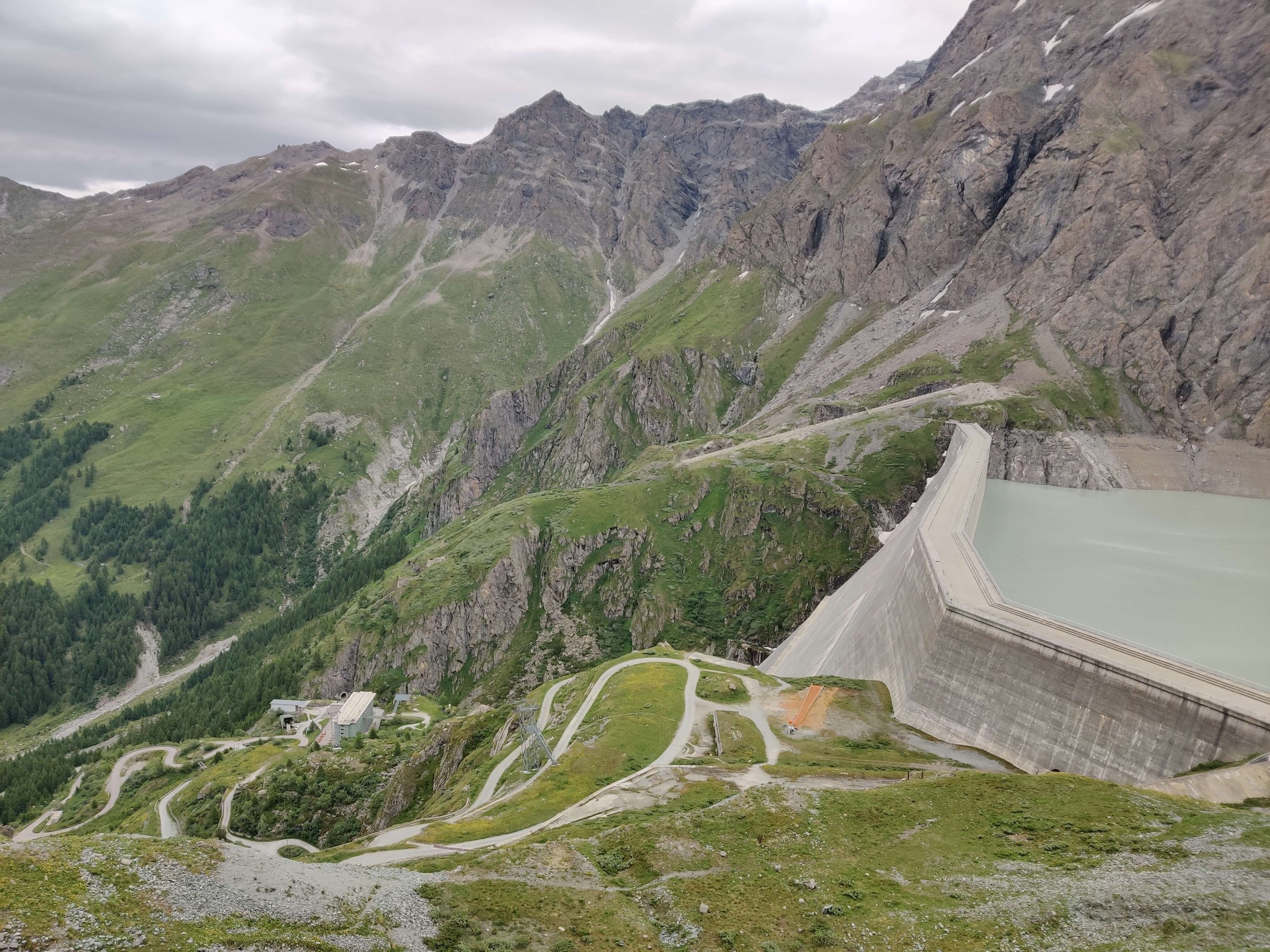
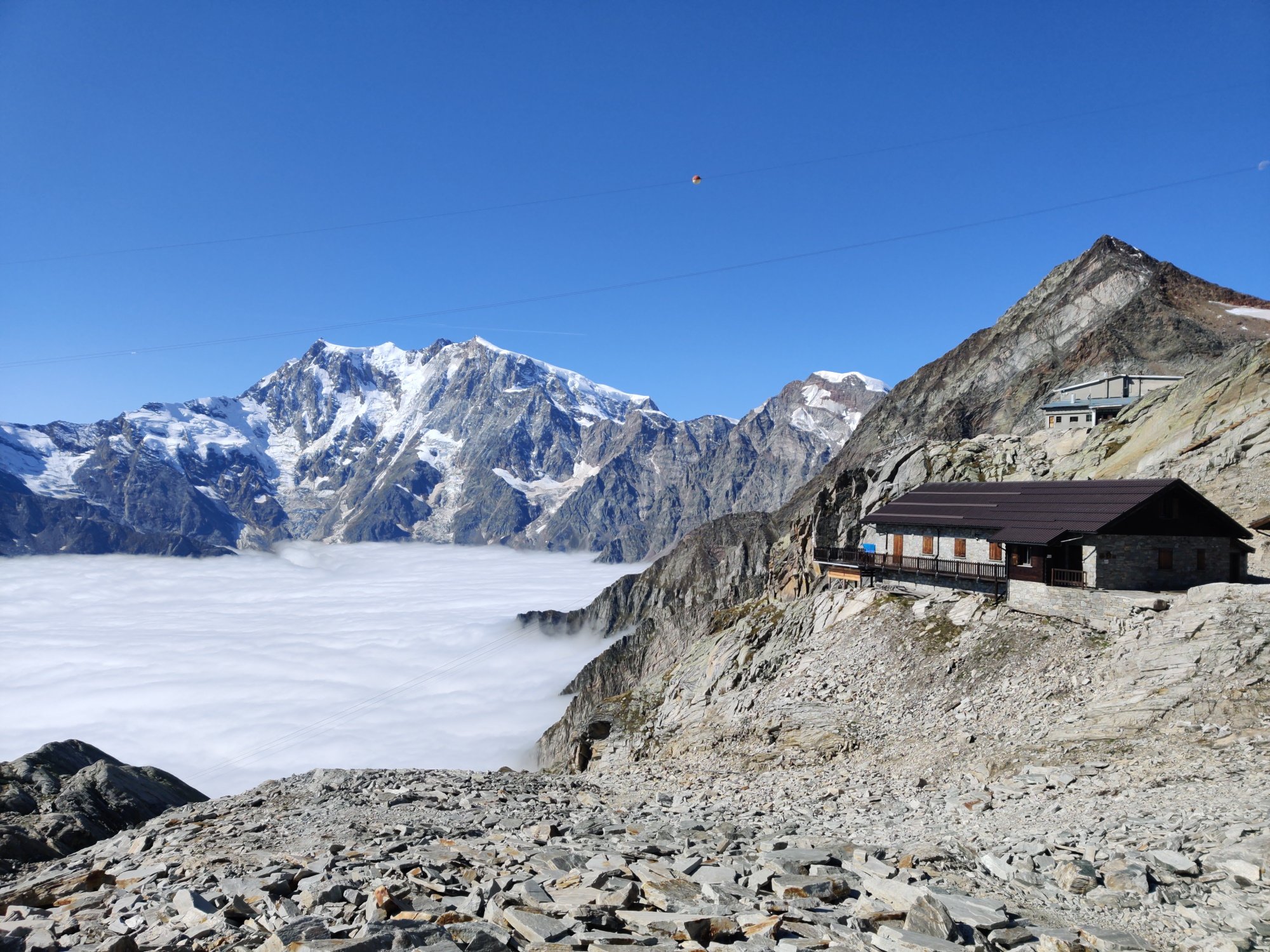
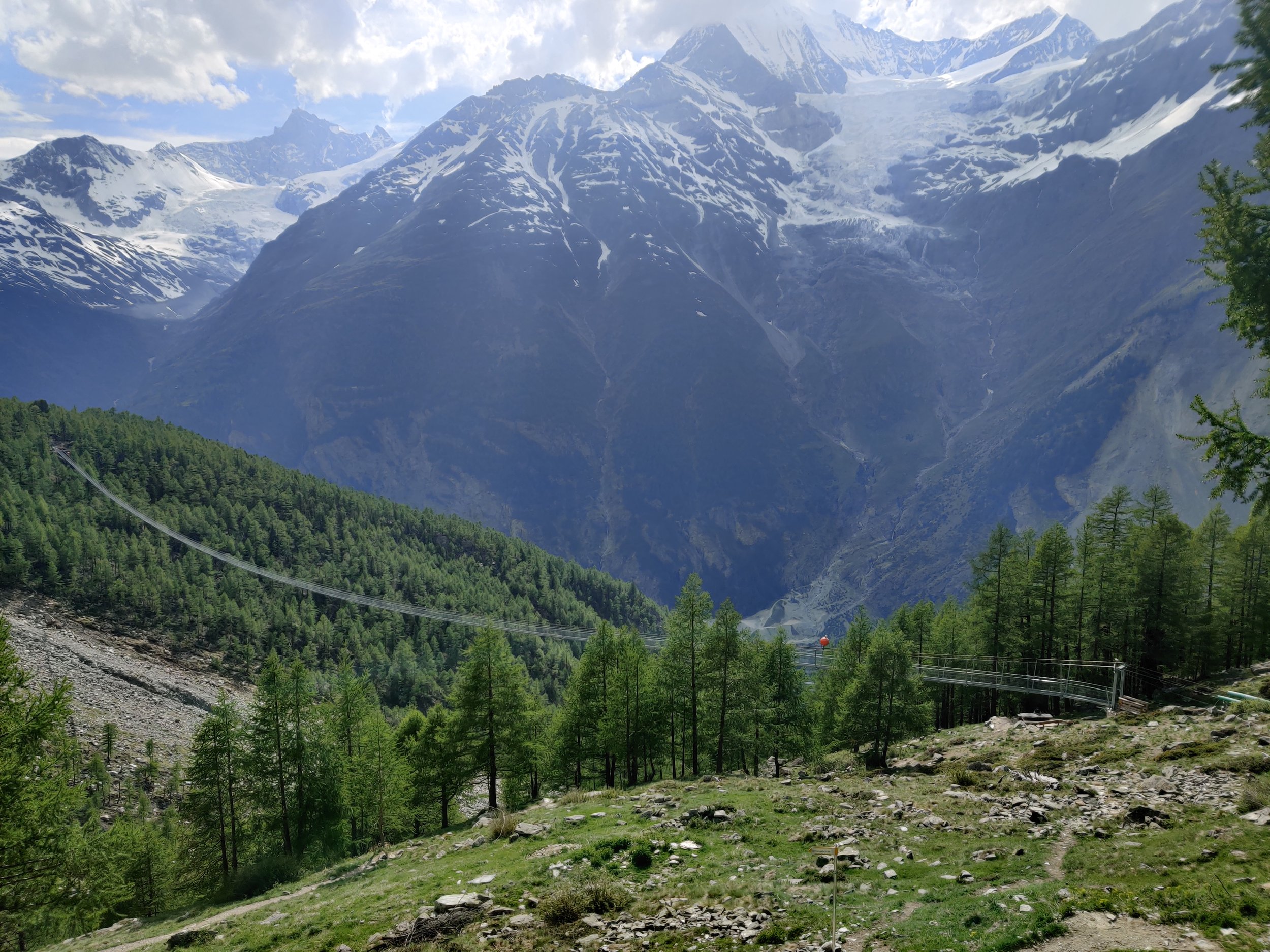
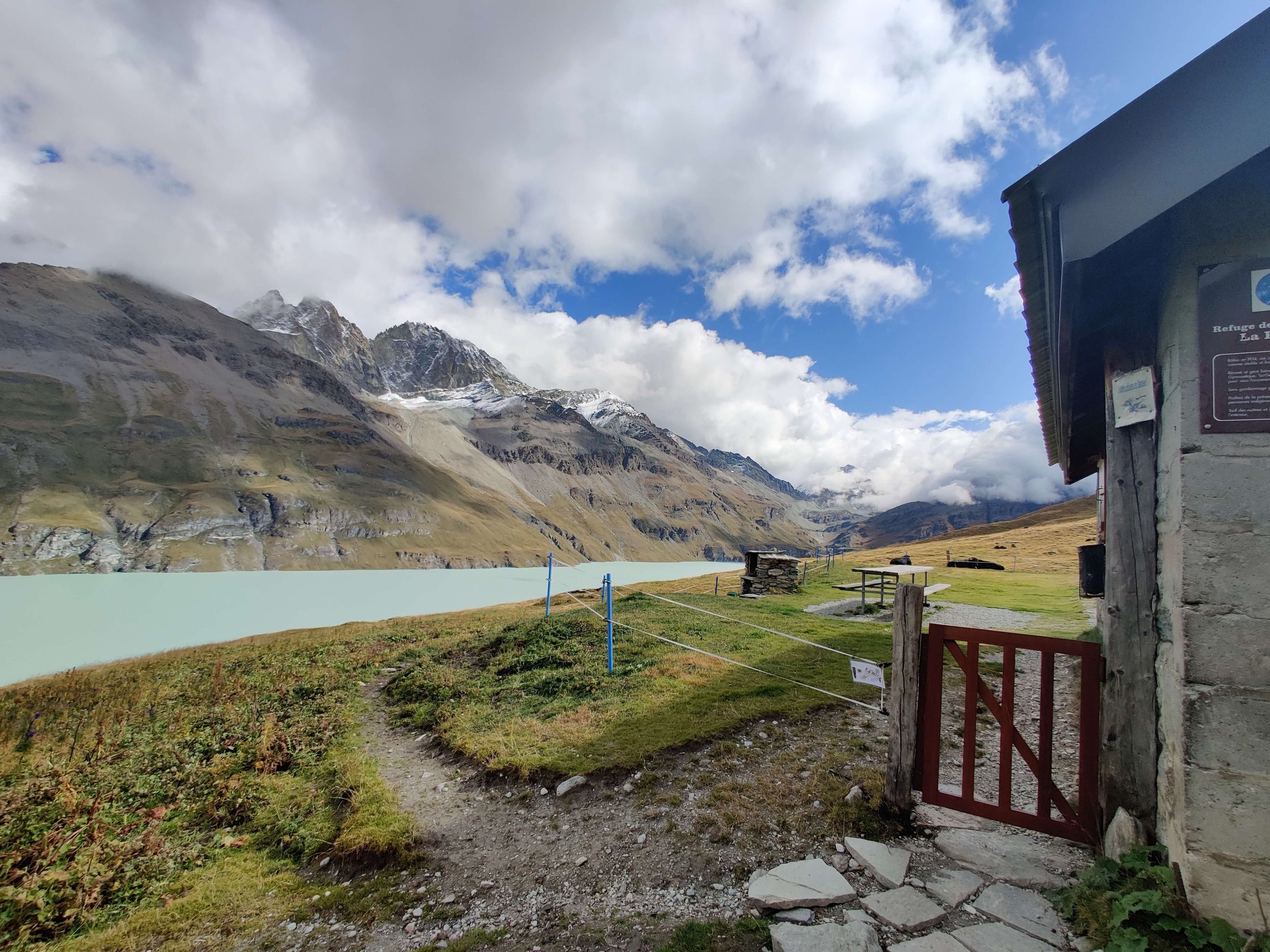
Col du Grand Saint Bernard holds particular historical significance as Napoleon crossed here with his army to surprise Austrian forces in Genoa. A famous painting (considered a propaganda masterpiece) was produced to mark the occasion and ultimate triumph of the campaign. In the painting, Napoleon is wearing a magnificent cloak on a rearing charger, when in actual fact, he crossed the pass riding a donkey, wearing a simple grey greatcoat. Hannibal is also etched into the foreground of the painting which aims to draw a comparison with other great generals and has fueled the debate as to whether Col du Grand Saint Bernard was where he crossed the Alps with his African war elephants to strike at Rome.
Napoleon crossing the Alps: Jacques-Louis David, Public domain, via Wikimedia Commons
The Pennine Alps is also home to The Great St Bernard Hospice was originally a monastic shelter founded in the Middle Ages, led by Augustinian monks. The hospitality of the monks is legendary and continues on as a hospice welcoming pilgrims and hikers, and a museum, today. Founded in 1049, the hospice became famous for its breeding and use of St Bernard dogs in rescue operations.
The Saint Bernard dog: Large size, and gentle temperament originally bred for rescue work by the hospice of the Great St Bernard Pass.
Hiking in this inspiring part of the world was where the idea for The Hiking Club was born and therefore thought there was no better location to kick off our ‘Trails of the world spotlight’. Many of you have experience hiking in the Pennine Alps so we’d invite you to share any highlights or interesting history from the area that you discovered.
Author: Brendan Jones, The Hiking Club
A pizza-making, craft beer-loving, peanut butter connoisseur that has been exploring the great outdoors since completing the Duke of Edinburgh Award in high school. He started The Hiking Club to democratise hiking and the benefits that come from spending time in nature. You can read more about Brendan and the team here.
WHO ARE WE?
The Hiking Club empowers anyone to walk the way they want in the wild with personalised self-guided hiking experiences that are easy to find, quick to plan and simple to navigate.
We believe hiking experiences have the power to transform lives. With a growing range of personalised hikes that take into account your preferences, fitness and interests, we give you everything you need to explore the legendary trails of the world!
A wildly rewarding alternative route
Instead of spending the 2021 European summer exploring new hiking routes in the Alps, I spent it on the other side of the world within 5km of my apartment. You can read more about that here. After a little wallowing in self-pity, I dusted myself off and went looking for a way to make the most of my situation. The University of New South Wales (UNSW) was seeking applicants for their Founder’s 10x business accelerator program. This was the alternative route I was looking for.
Hiking in the Alps: 2021 Season Report
For those who could reach the Alps, COVID-19 restrictions impacted the hiking season for a second year running. At the start of the season, there was much excitement and anticipation about a COVID-19 EU Travel Certificate finally allowing tourism to resume in Europe. The silver lining of a delayed reopening for international hikers was that the conditions were not favorable for early-season hiking. There were new accumulations of snow on the high mountain trails until about the 20th of May…
Finding your people: a global hiking community
When I started walking the Camino de Santiago it didn’t take me long to realise I had found my people. In fact, only about 2km. I met Viviane, who like me, was on day one of this ancient pilgrimage trail. As we walked we enjoyed our new friendship that was fun and easy, having been instantly built on our shared love of a new adventure.
780km and 38 days later, I stood at the foot of the Cathedral of Santiago de Compostela, the end of my journey, and feeling … well, honestly, not much at all. It was simply because, for me, walking this camino was less about the destination or even the trail (although it is amazing, don’t get me wrong!); it was all about the incredible people, like Viviane, who walked alongside me. They are my people.
I continue to find these people on every hike I’ve done since. On trails through fields, farms, villages, cities, valleys and mountains, their company and their stories empower me.
It is for this reason, we at The Hiking Club are laying the foundations for a community of hikers and adventurers!
This is a place for all hikers to share a love of walking in the wild. Whether you’re wandering the hills of the South Downs, trekking through the mountains of the Swiss Alps, hiking the Timberline Trail, walking the Camino de Santiago (highly recommend!), or you’re exploring the trails of your local national park…we believe everyone has a hiking story to tell (big or small!) and that story has the power to inspire others.
What we stand for
The global hiking community is filled with adventurers, each as unique as the trails they walk. It is this tapestry of personal experiences bound by a shared love of spending time in the outdoors that is truly special and worth celebrating.
The aim of The Hiking Club community is to create a place of discovery where you can be inspired by, and connect with, other hikers.
Inspire. Be inspired by the stories of other hikers and discover new places to explore! Share your own story and the amazing places you’ve visited, what trails you’d recommend, and your own incredible experiences.
Connect. Find your people. This is the place to meet fellow hikers from around the world in between adventures. Ask a question, share an idea, or simply reach out to a group of people who come from all corners of the globe.
Grow. Through stories, experiences, tips and recommendations, we hope this community will encourage and motivate us to grow in confidence, expand our knowledge, and reach our hiking potential.
If you love hiking, love walking in nature and love the adventure of the trail, then we are your people!
Join The Hiking Club community - we can’t wait to meet you and hear your stories from the trail.
Author: Greta Stevens
Greta discovered a love for multi-day hiking on the Camino de Santiago and has never looked back. She co-created the Modern Adventurers book with The Hiking Club before joining the team full time to help empower a global community of adventurers to walk the way they want in the wild!
Who are we?
The Hiking Club empowers anyone to walk the way they want in the wild with personalised self-guided hiking experiences that are easy to find, quick to plan and simple to navigate.
We believe hiking experiences have the power to transform lives. With a growing range of personalised hikes that take into account your preferences, fitness and interests, we give you everything you need to explore the legendary trails of the world!
Trail and COVID-19 Update
2021 Walker's Haute Route Trail Conditions
2021 Tour du Mont Blanc Trail Conditions
2020 Tour du Mont Blanc Trail Conditions and Update
Tour du Mont Blanc: The Main Trail
The “main” Tour du Mont Blanc trail is 166 km / 103 mi and travels around Mont Blanc, Europe’s highest mountain at 4,810m (15,781 ft). The trail crosses 10 mountain passes with a total elevation gain of just under 10,000m (32,700ft). Hikers will see alpine lakes, magnificent glaciers and lush meadows. The Tour du Mont Blanc is one of the legendary multi-day hikes in the Alps. Read our detailed blog post which takes a “walk” through all the different sections of the main Tour du Mont Blanc trail, including images, descriptions and trail stats.


